1lumen selects and reviews products personally. We may earn affiliate commissions through our links, which help support our testing.
Fenix LR40R V2.0 review
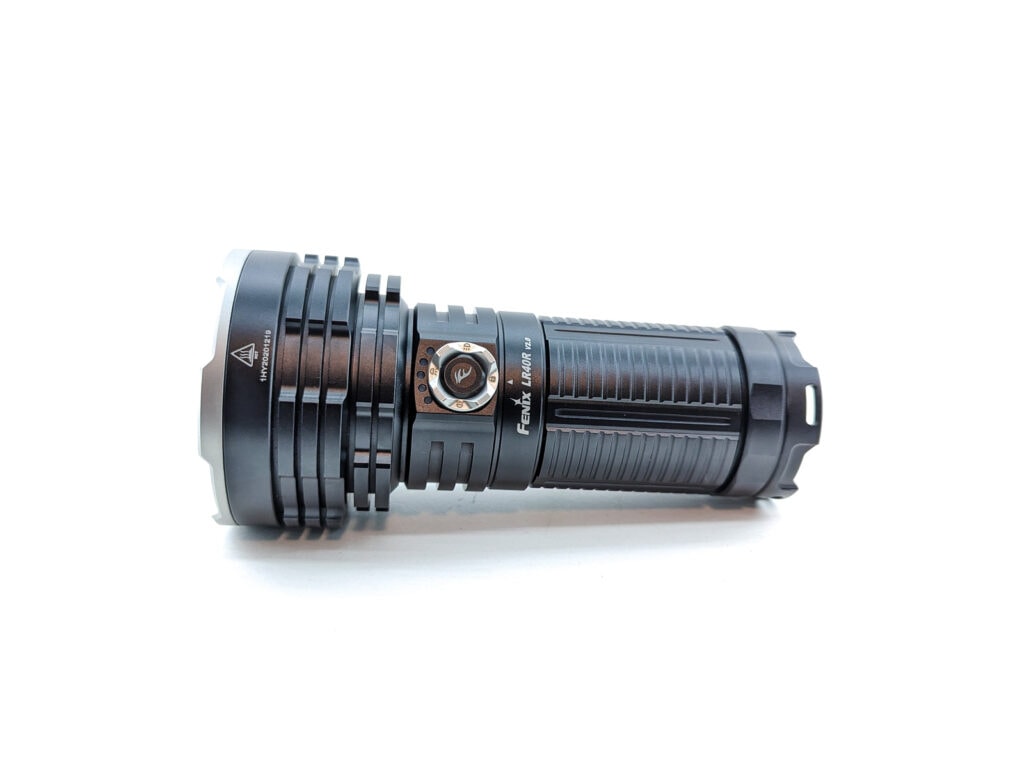
Fenix LR40R V2.0 specs
| Brand & Model | Fenix LR40R V2.0 |
|---|---|
| Flashlight category | Long-range, lumen-monster, search light |
| LED | Luminus SFT70 + 16 Lumileds HL2X |
| Max. output | 15,000 lumens |
| Max. beam distance | 900 meters |
| Max. beam intensity | 203,568 cd |
| Battery config. | Battery pack (3x 21700) |
| Onboard charging | USB-C |
| Modes | 14 |
| Blinkies | Strobe, SOS |
| Waterproof | IP68 |
| Review publication date | May 2023 |
Review intro:
Fenix makes a huge array of lights. In fact, they have an actual PDF catalog on their website (I imagine it’s probably also distributed in paper form as well) that is 48 pages long and chock-full of products ranging from tiny EDC lights all the way up to a couple really big boys that I’ve been fortunate enough to check out: the Fenix LR50R 12,000 lumen monstrosity and the Fenix HT30R 1500m throw LEP. If you need a light, chances are that Fenix will have a nice offering to fill that need.
By and large, I really like Fenix – my first “real” flashlight was a Fenix (the 187 lumen E25 model, if you’re curious). From my experience, Fenix lights are really well designed, they use quality materials and finishes, have great constant-current drivers, and publish truthful ANSI specs. I recently reviewed the small E18R V2.0 EDC light, the small-midsize PD25R, as well as the PD36R Pro – all were very nice lights. Today I’m reviewing the new LR40R V2.0, an entry in Fenix’s long-range LR series. I’ve actually reviewed another LR model before, the LR50R, which was an absolute unit. The updated LR40R model refines the operation of the flashlight and boasts increased output and range. The LR40R V2.0 is a combo spotlight + floodlight. This big boy puts a ton of light and can put it down range, too.
Getting started with the Fenix LR40R V2.0 is as easy as it gets: remove the flashlight from the box! The battery pack is built-in, so there’s no insulation disc to remove.
Package quality.
For a flashlight in this price range, you expect nice packaging even if the packaging really isn’t all that big of a deal. Fenix did not disappoint! The LR40R V2.0 arrived in a large, two-piece nested box with plenty of images, designs, and information on the outside. On the inside was a dense foam, custom-cut for this application. Foam aside, the box contained:
- Fenix LR40R V2.0
- Holster
- Lanyard
- Charging cable
- Instruction manual
- Warranty card
- Mini product brochure
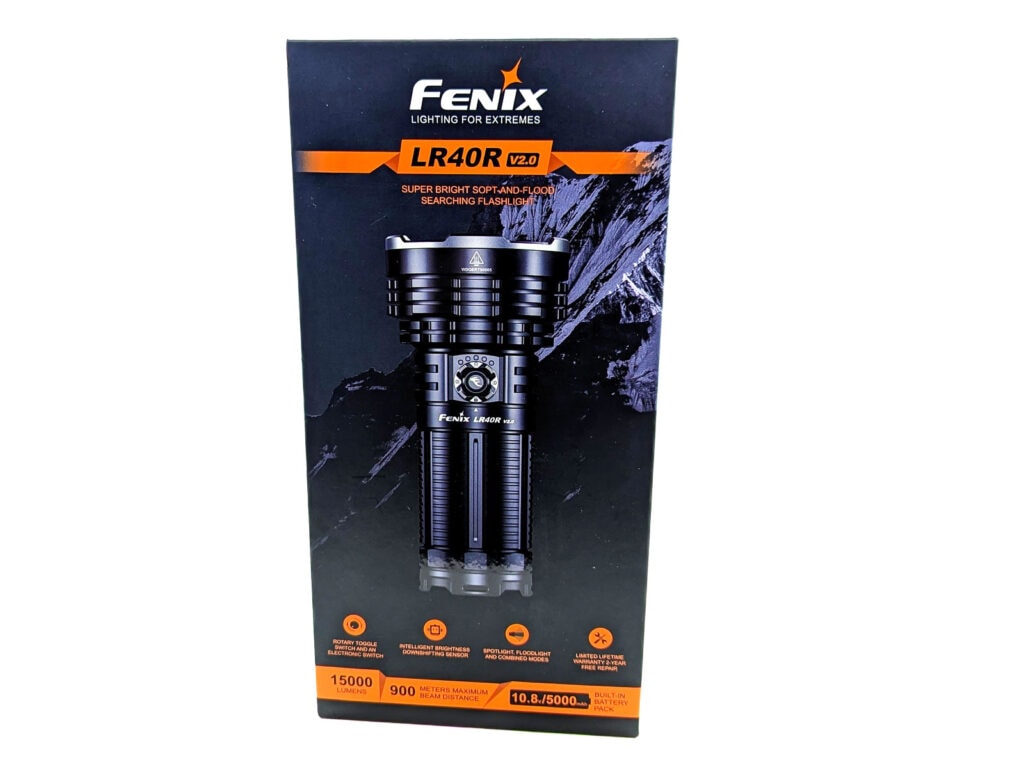
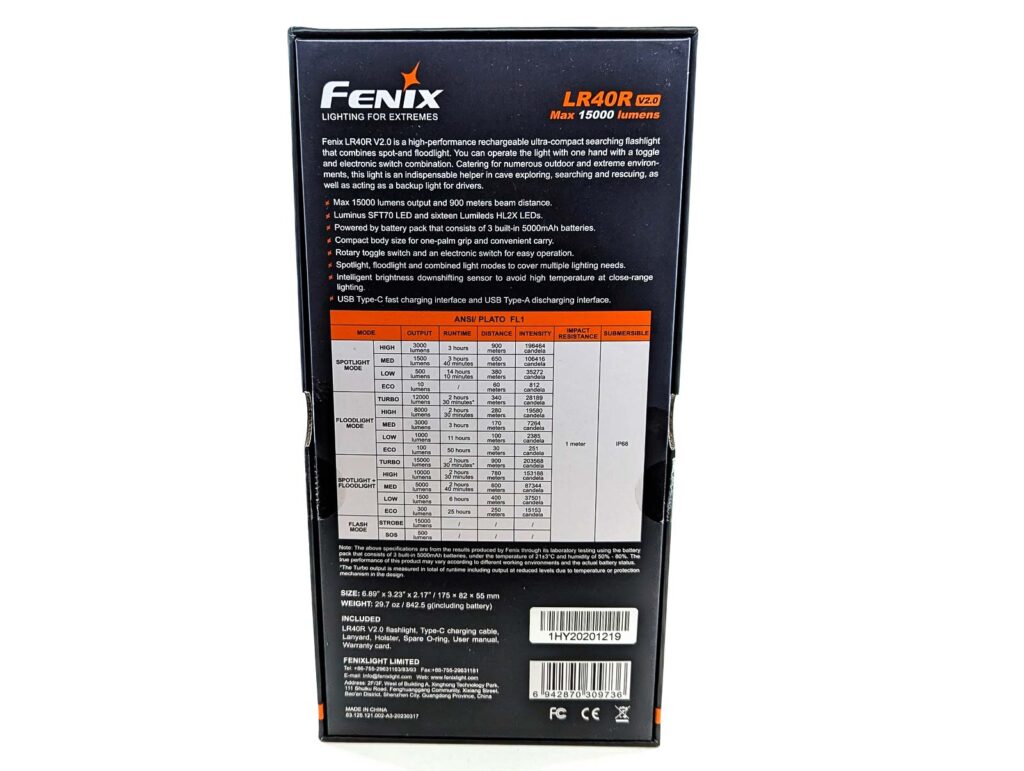
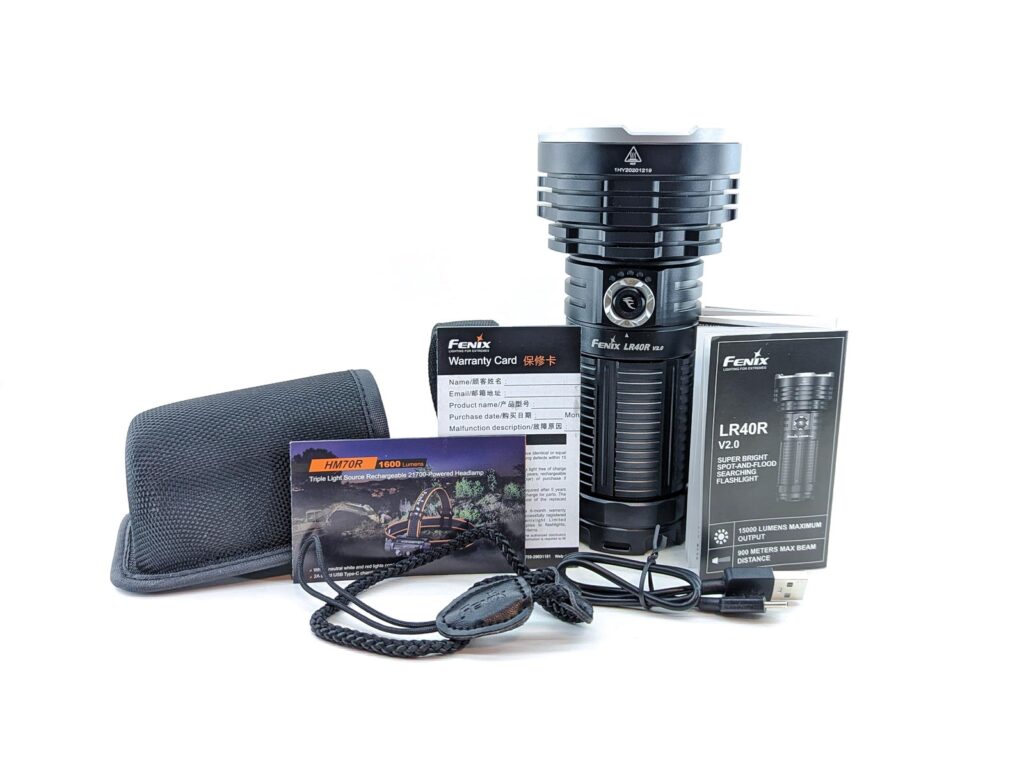
Flashlight in use
Have you ever held a large soda-can light like the Astrolux MF01X, the Convoy 3X21A, or Lumintop GT3 Pro? The Fenix LR40R V2.0 feels a lot like those, but even bigger and badder! It’s definitely a handful, but it is comfortable to hold and use. The controls consist of a rotary toggle switch for mode selection and an electronic switch that sits inside the rotary switch. At first I was worried about the usability of the rotary switch because the icons are so small and you can’t see them when it’s dark out. However, I quickly found that it wasn’t an issue because the originating position is Off/Lock and then you scroll through Spotlight, then Floodlight, then Combo (spot + flood). The ring does not twist all the way around – after hitting the Spot+Flood mode in a clockwise motion, you have to reverse and go counterclockwise.
The Fenix LR40R V2.0 ships with two nice carry accessories. The first is a tailor-fit holster with a formed pocket and a hook & loop (aka, Velcro) strap up top to secure it. There is also a nice lanyard included. It has the Fenix logo on it and the strap seems pretty heavy-duty as far as lanyards are concerned – which is great for such a beastly flashlight.
The base of the flashlight makes tailstanding a cinch. Combined with the several floody modes available, the LR40R V2.0 could make a nice room-fill light during a power outage. Sadly, there is not a tripod mount, which I could see being handy.
What can you do with the Fenix LR40R V2.0? I think the better question is what couldn’t you do with it. Well, I suppose you wouldn’t want to carry it on a keychain. First and foremost, Fenix bills this as a Search & Rescue flashlight. Whether you need to cover long distances over a lake or light up an entire field or parking lot, the LR40R V2.0 has a mode that’s up to the task. And sure, it could make a good hunting companion. I suppose you could walk the dog with it, and your arms might just get a workout at the same time, win-win!
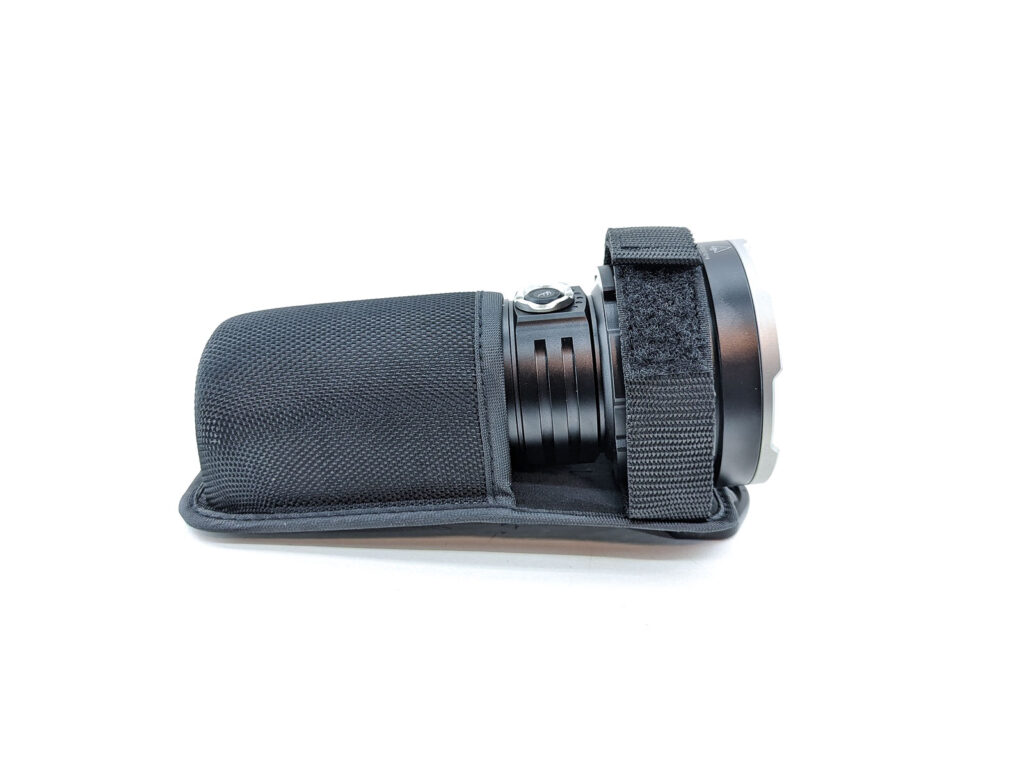
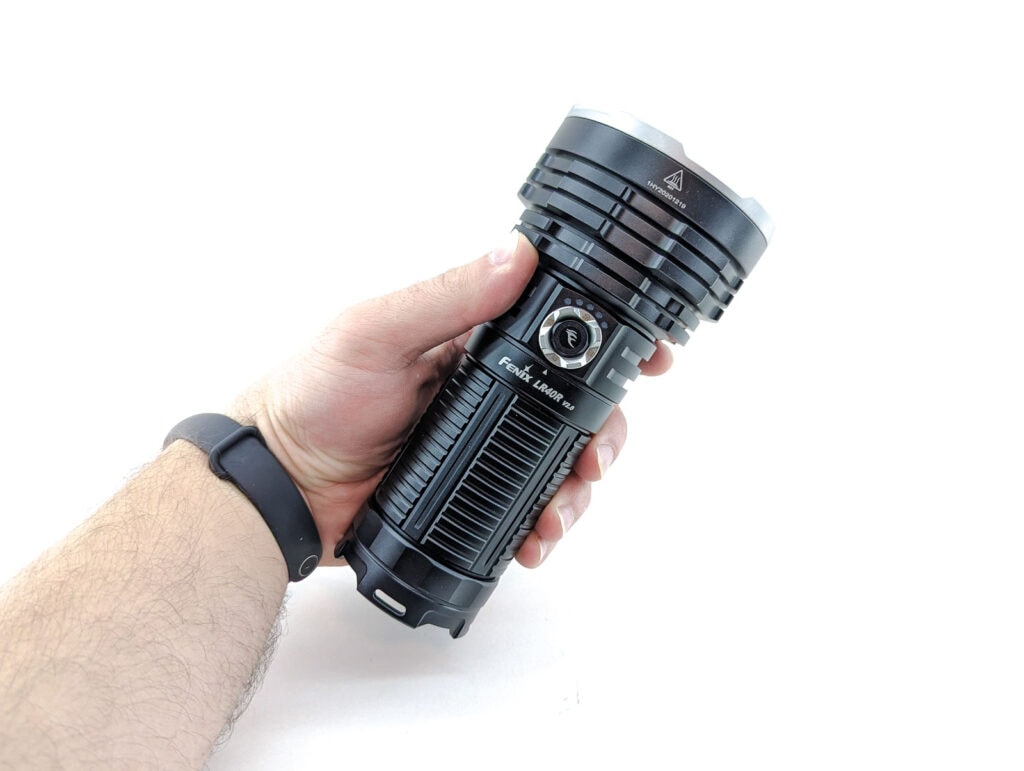
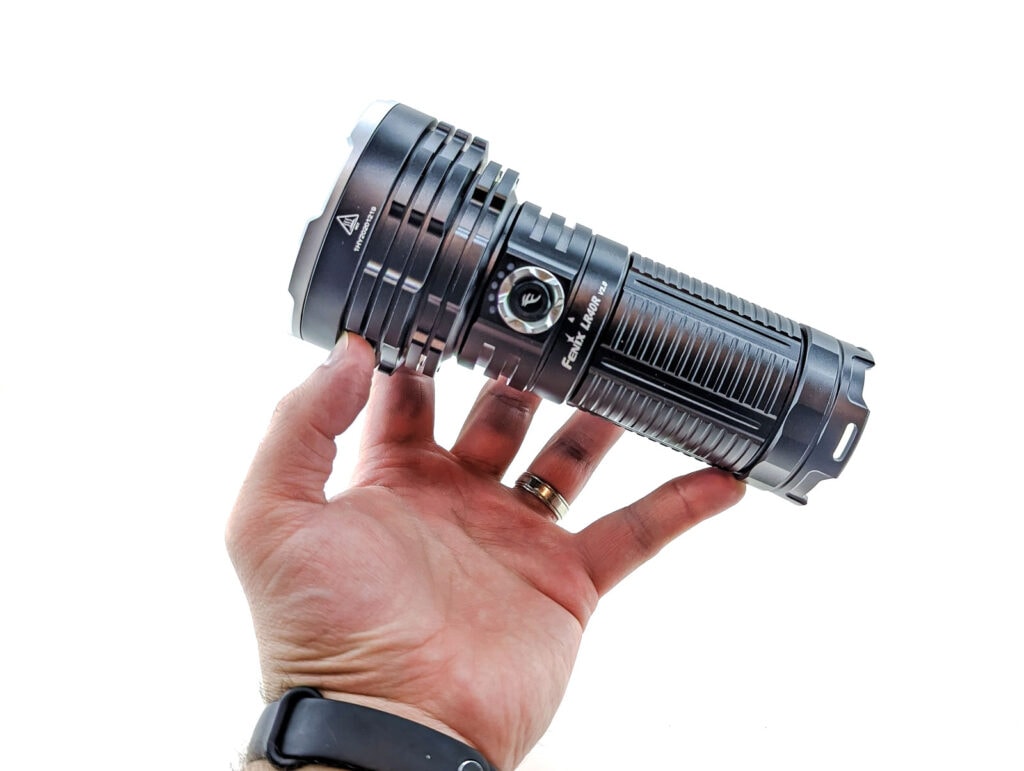
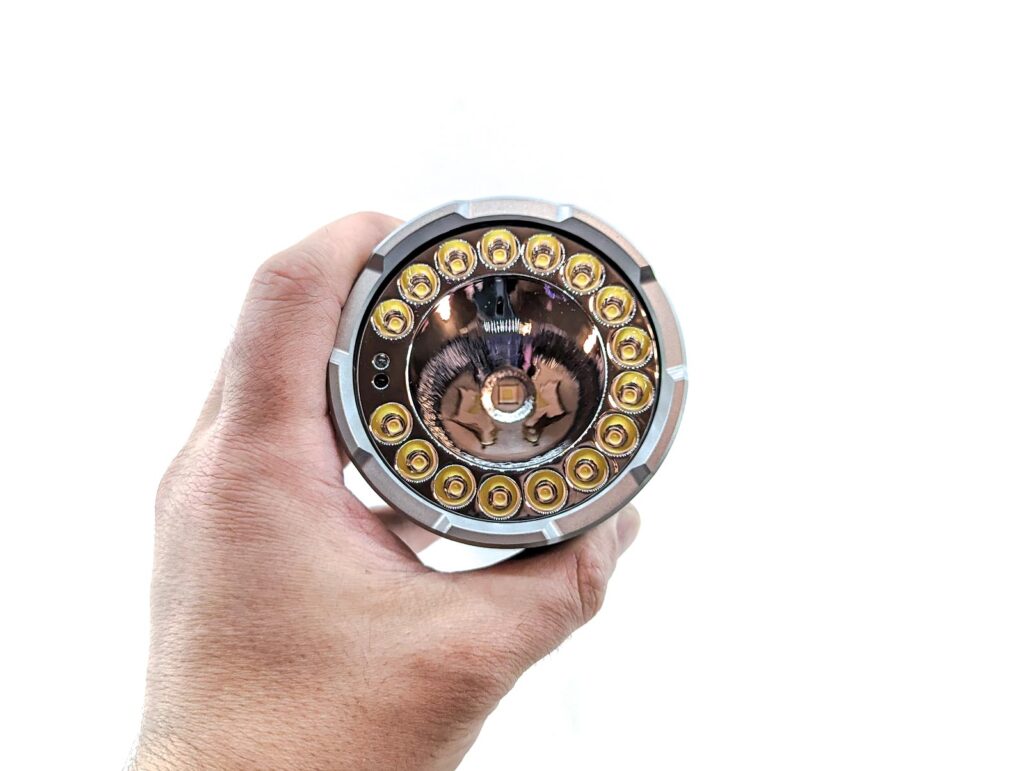
Build Quality and Warranty
The Fenix LR40R V2.0 foregos the usual knurling, and instead has a series of rings and grooves milled into the body that provide a reasonable amount of grip. The anodizing (HA III) on the aluminum is a satin black, but does have a slight sheen to it. Overall, the flashlight feels great in the hand and leaves no cause for concern regarding build quality. The fit and finish look absolutely great, as I’ve come to expect from Fenix.
Warranty:
- 15 days from date of purchase: replacement from Fenix for manufacturing defects
- 5 year from date of purchase: free repairs
- Lifetime maintenance, with customer covering the cost of parts
- Extra 6 month warranty period for products registered on Fenix’s website
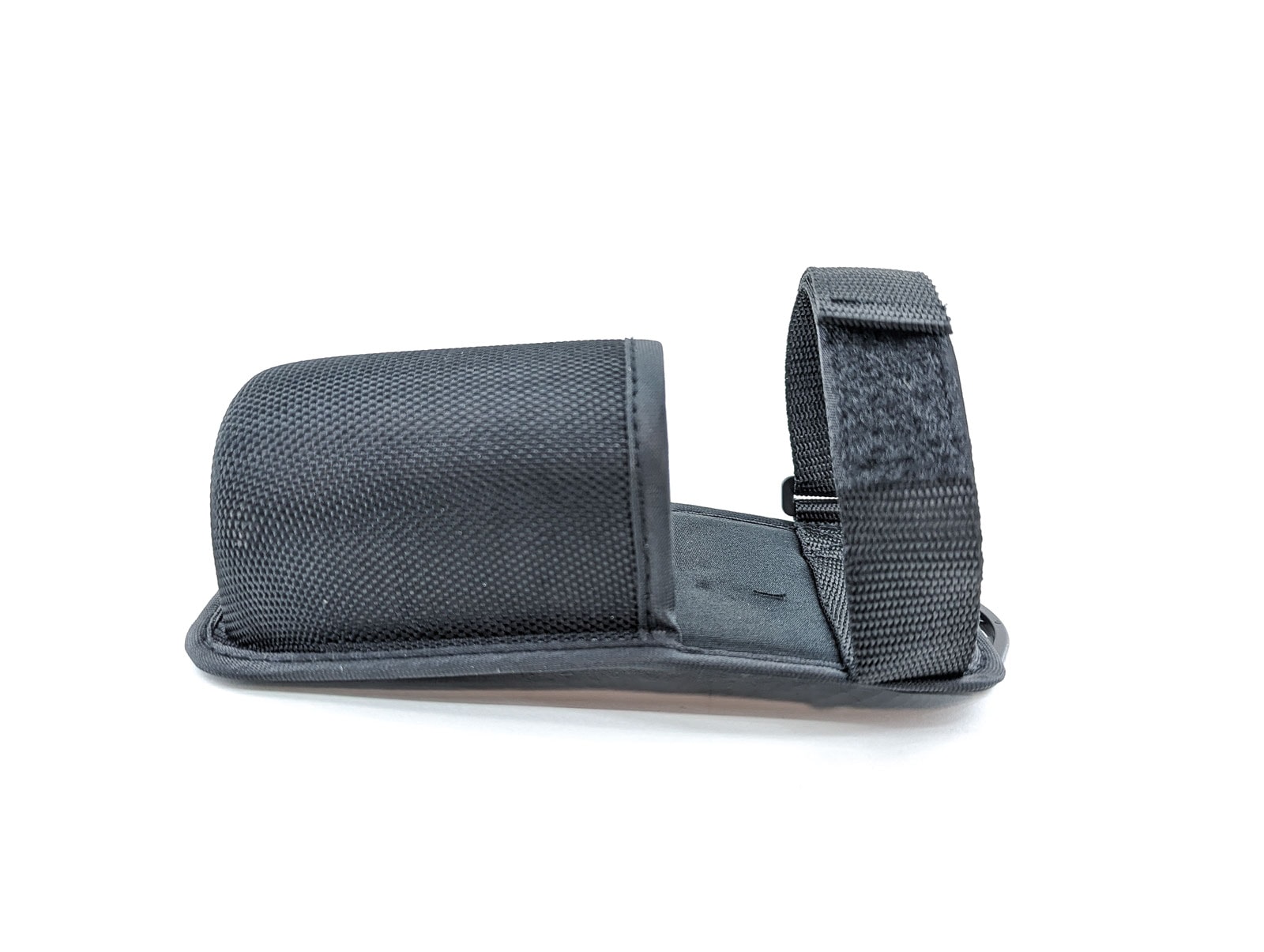
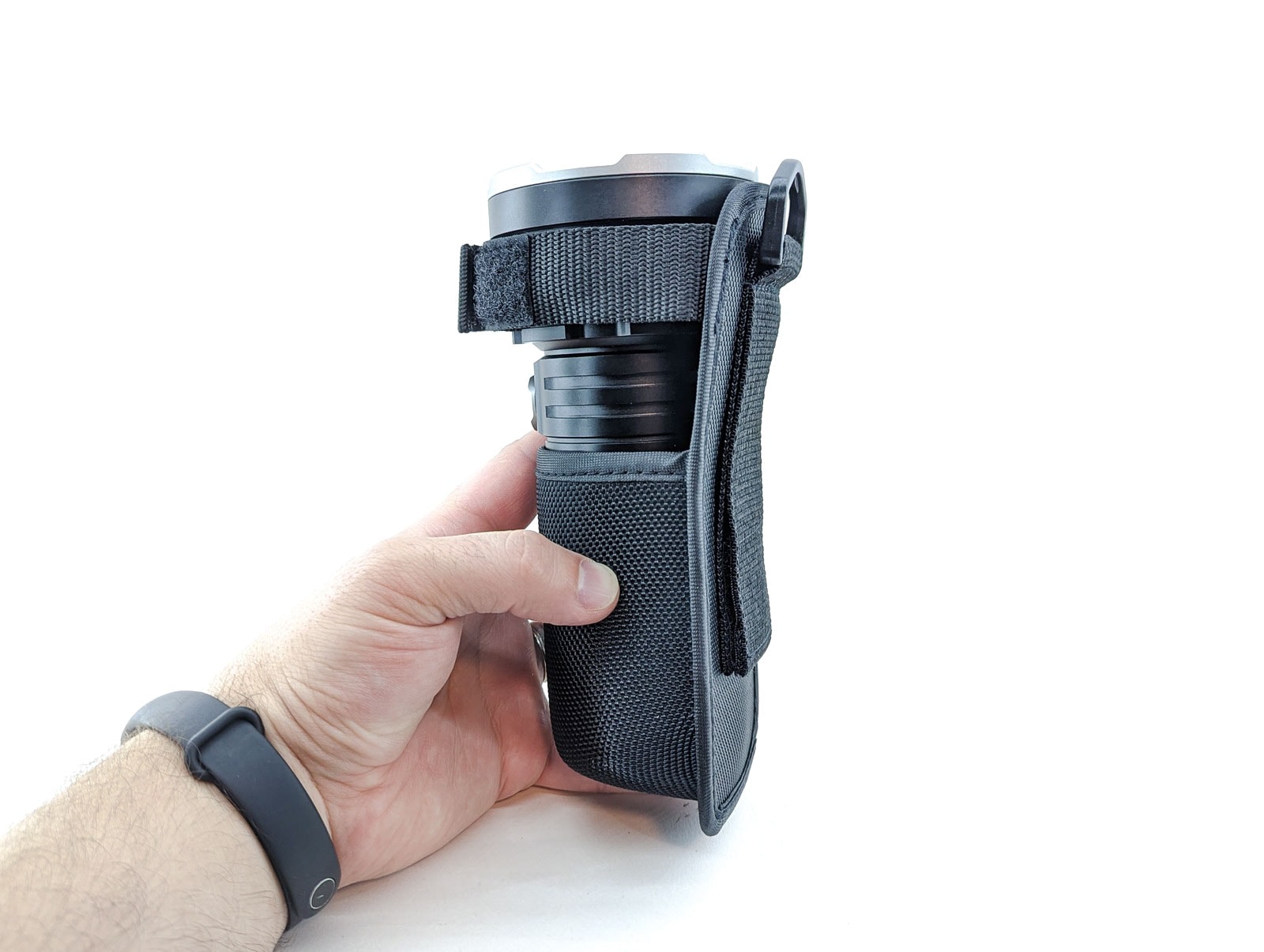
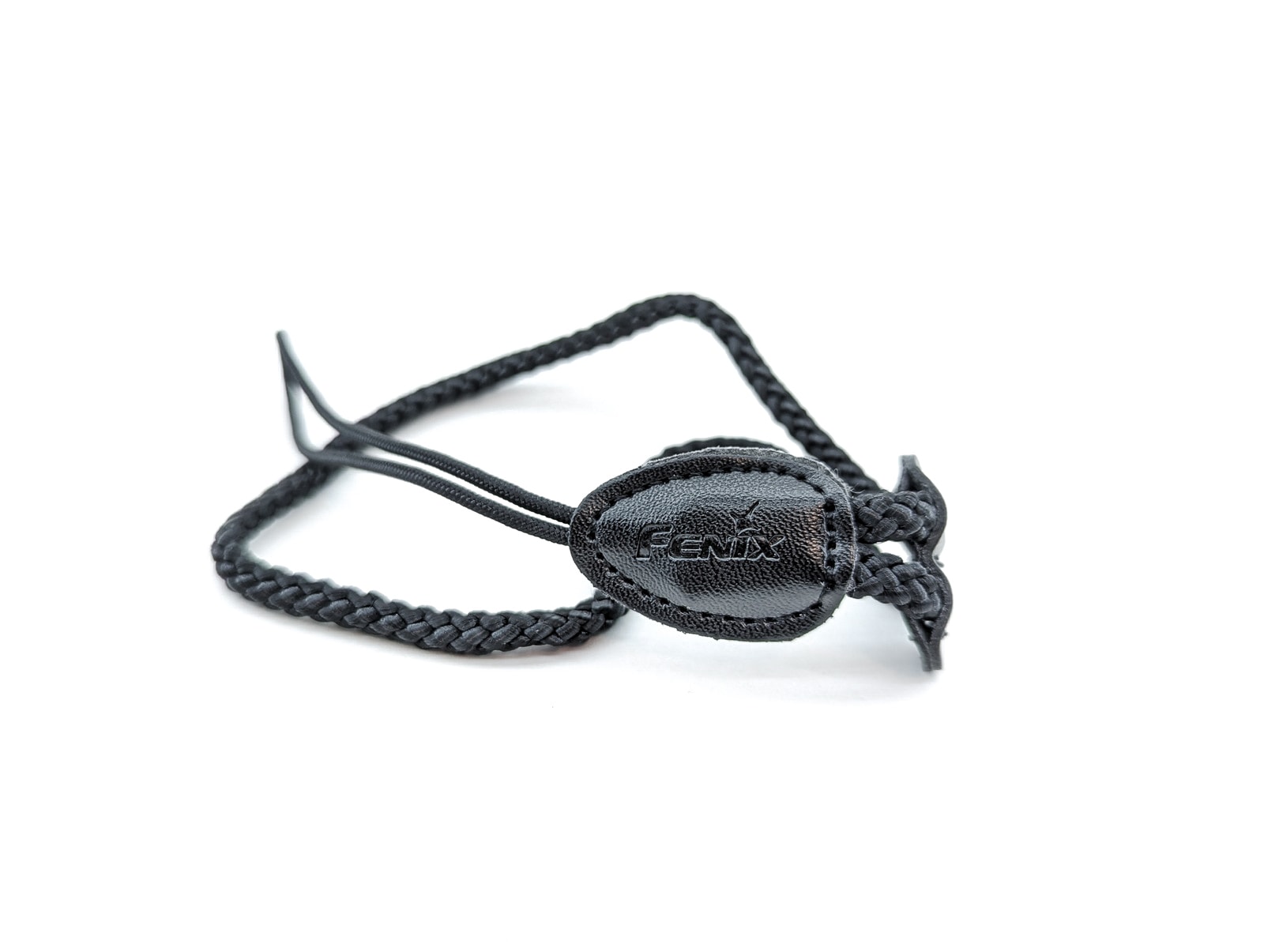
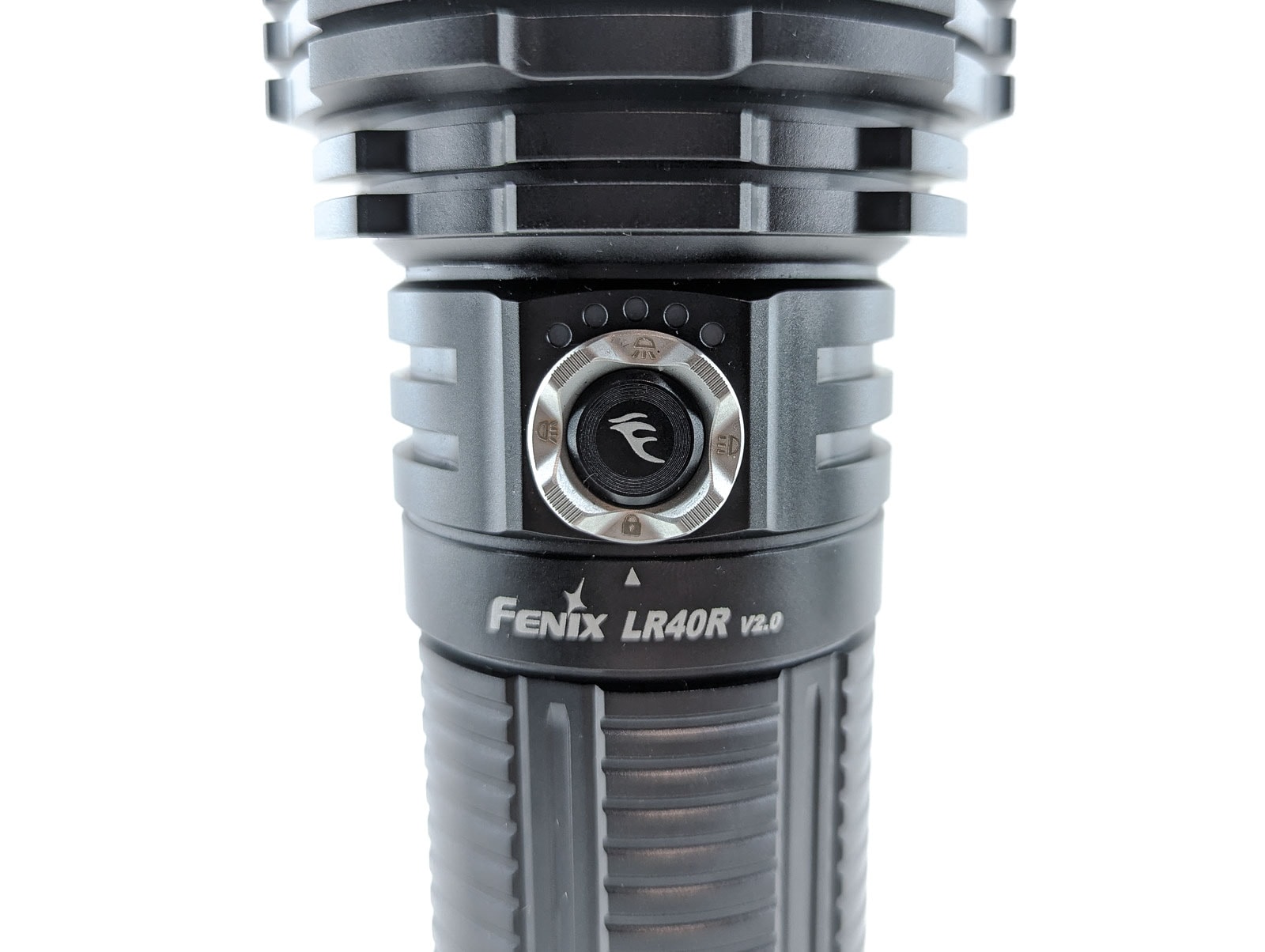
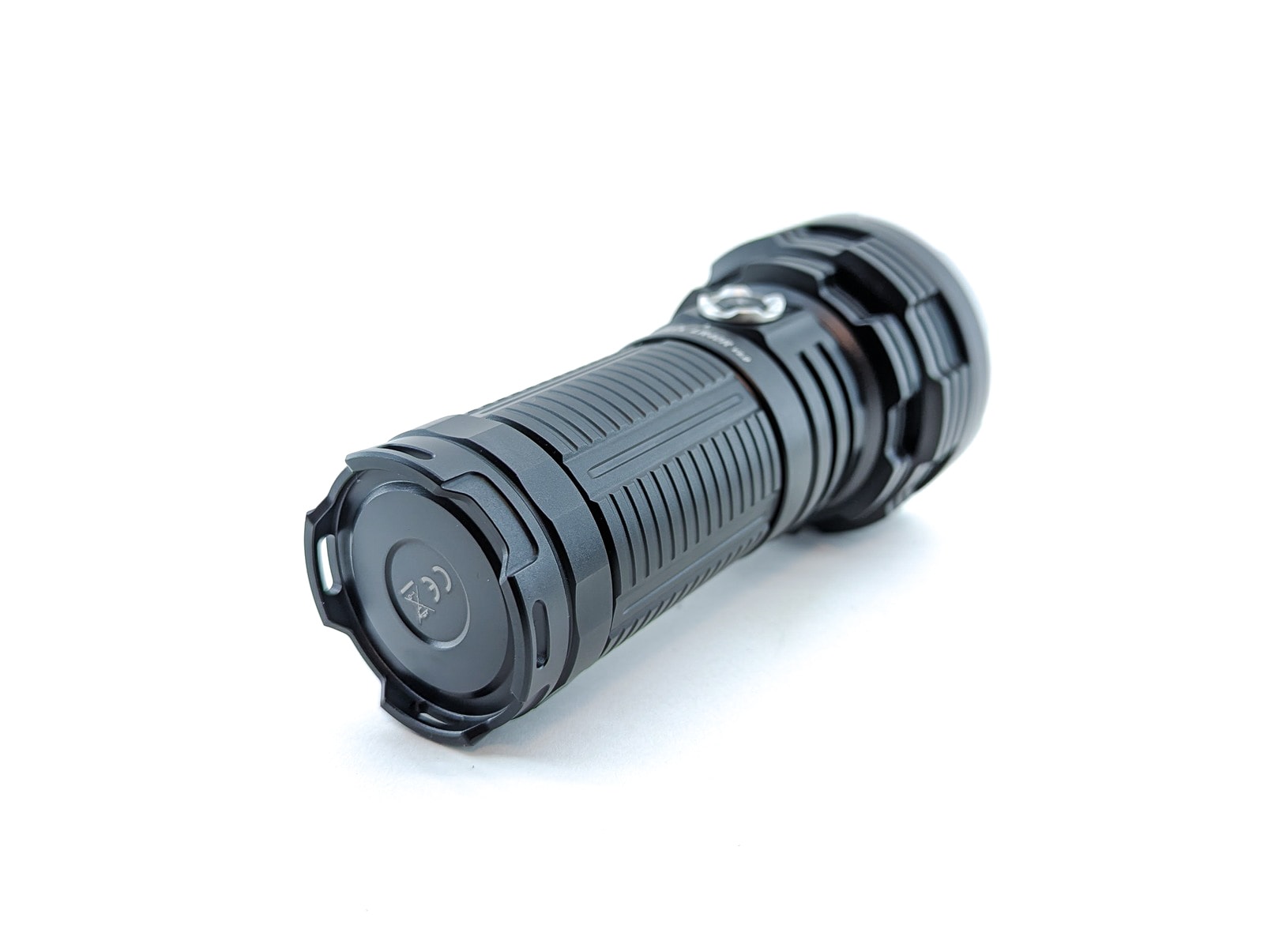

LED, Lens, Bezel, Beam, and Reflector
The Fenix LR40R V2.0 is fairly unique in the dual-channel aspect. Over the past year or so I’ve noticed a handful of lights offering both Spotlight and Floodlight modes, though it’s still not something that I would consider to be common. The Fenix achieves this with a large central reflector that houses a Luminus SFT70 LED. It’s the “big brother” to the more common SFT40. These are domeless emitters that put out a lot of concentrated light.
The central reflector is surrounded by 16 little reflectors, each one housing a Lumileds HL2X LED. This little (3535 size) Luxeon LED has been around for a few years, had some testing done at BLF, and never really seemed to generate much interest in the enthusiast space. Understandable… but when you put 16 of them together, at that point it’s more about quantity and not quality. And these things end up putting out a lot of light in the LR40R V2.0. That makes it a real high lumen flashlight.
Up front with the LEDs, you might notice a couple extra bits in the reflector. Those are part of the “intelligent brightness downshifting sensor”. That’s a handy feature in day-to-day usage, but a little annoying for testing. Thankfully that functionality can be disabled.
The bezel is a large ring of what appears to be matte stainless steel. It is lightly crenulated, which I like because you’re able to tell if you accidentally turned the light on when it’s face down (not that it’s a particular problem with this like – I’m just speaking in general).
The Spotlight beam is nice and tight, thanks to the larger reflector and the domeless LED. The Floodlight mode is really broad, as you’d expect from this LED arrangement in tiny reflectors.
Measurements from the Opple Light Master at 5 meters and highest brightnesses:
- Spotlight Mode:
- CCT: 6751K
- CRI: 70.1 Ra
- DUV: +0.0034
- Floodlight Mode:
- CCT: 5617K
- CRI: 68.4 Ra
- DUV: +0.0103
- Spot + Flood Mode:
- CCT: 6357K
- CRI: 68.6 Ra
- DUV: +0.0056
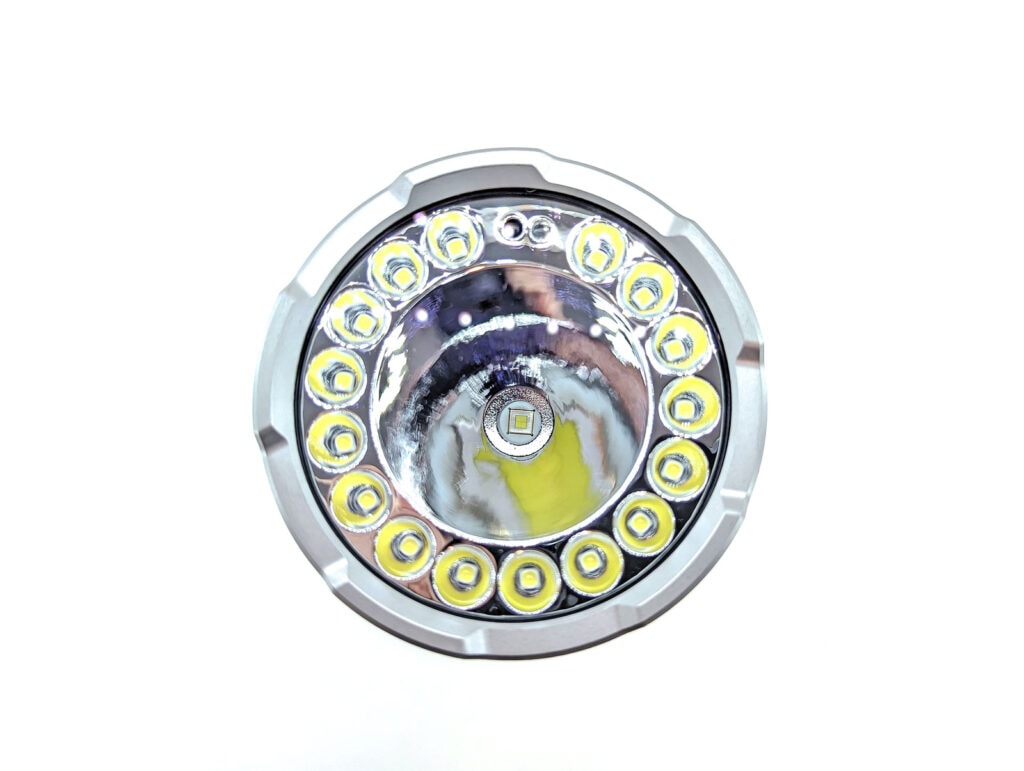

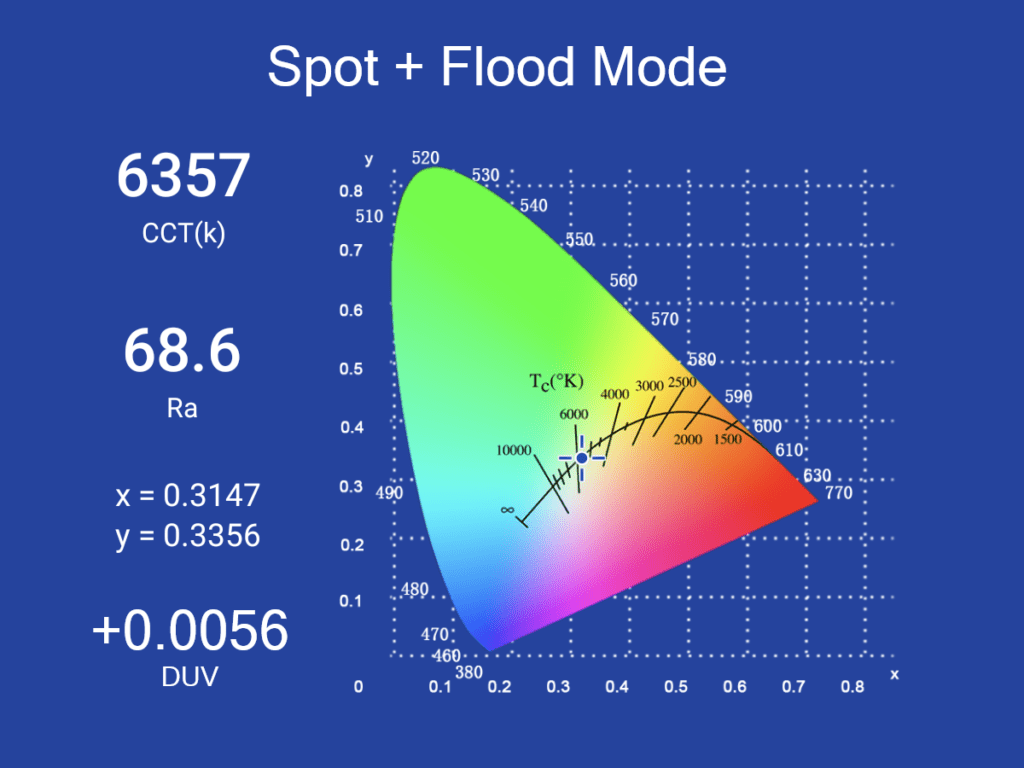
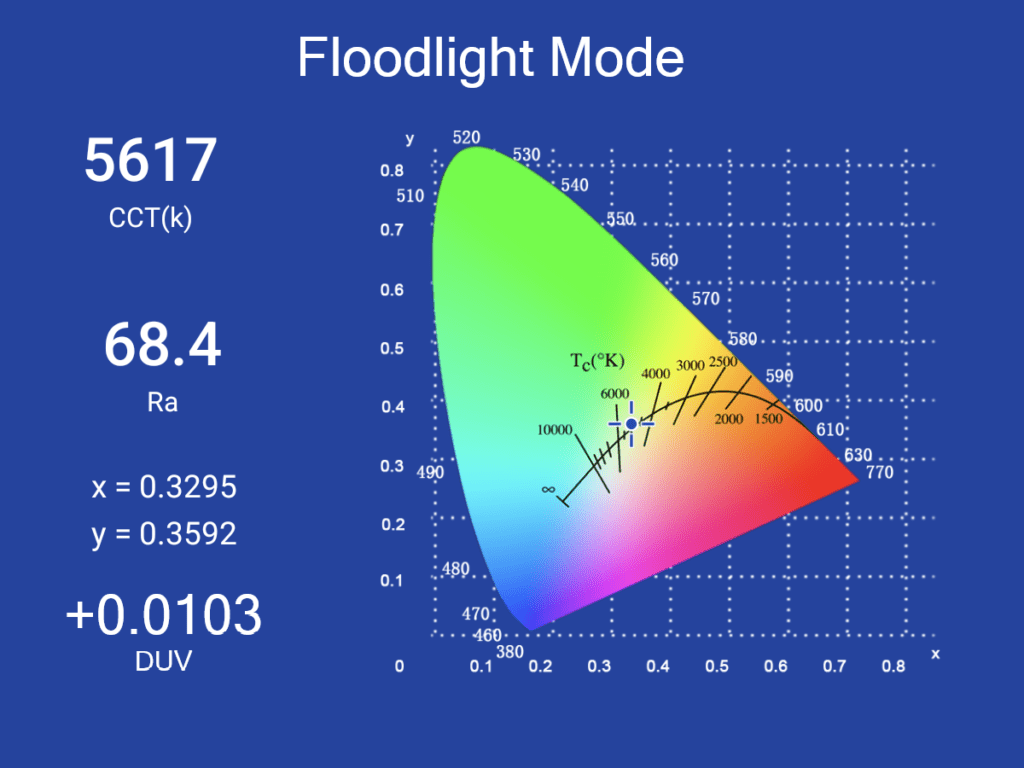
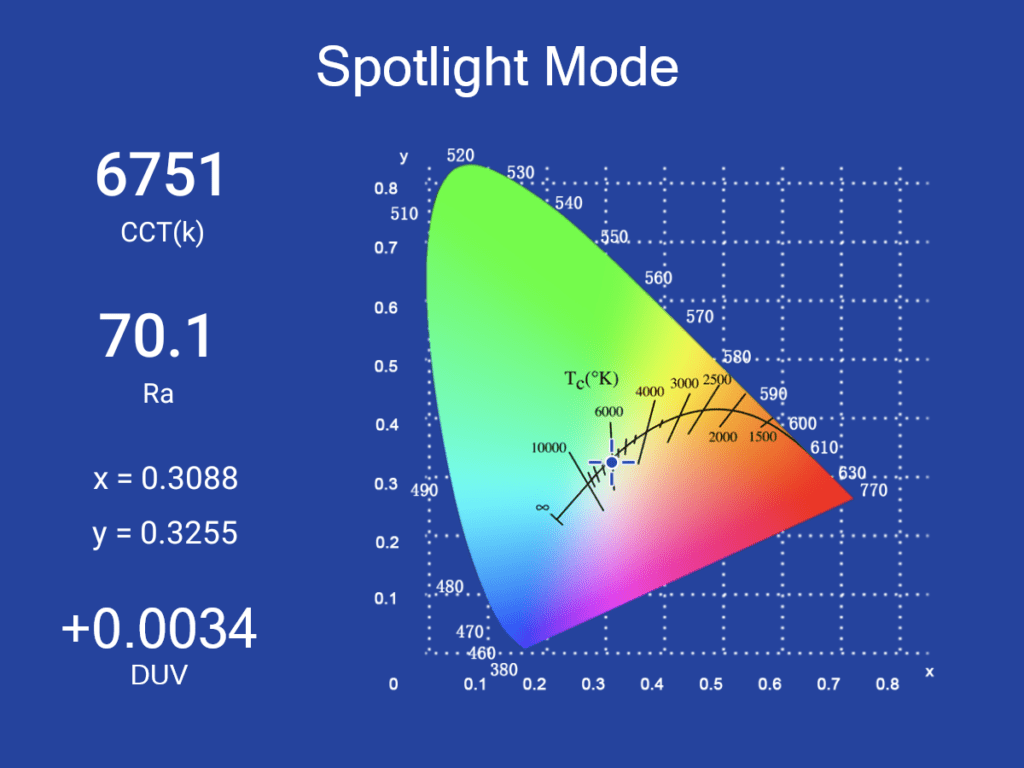
Dimensions and its competition
Dimensions:
| Fenix LR40R v2 | Millimeters | Inches |
|---|---|---|
| Length | 175 mm | 6.9 in |
| Head diameter | 82 mm | 3.2 in |
| Body diameter | 55 mm | 2.2 in |
Dimensions are rounded to the nearest millimeter, and to the nearest tenth of an Inch.
Weight:
| Fenix LR40R v2 | Weight in grams | Weight in oz |
|---|---|---|
| Without battery: | N/A | N/A |
| With battery | 843 g | 29.7 oz |
Weight is rounded to the nearest gram, and to the nearest tenth of an Oz.
Flashlight size comparison with its competition:
Group 1 Fenix flashlights: Fenix LR40R V2.0, Fenix LR50R
Group 2: Lumintop GT3 Pro, Fenix LR40R V2.0, Convoy 3X21A
Group 3: Fenix LR40R V2.0, Astrolux MF01X

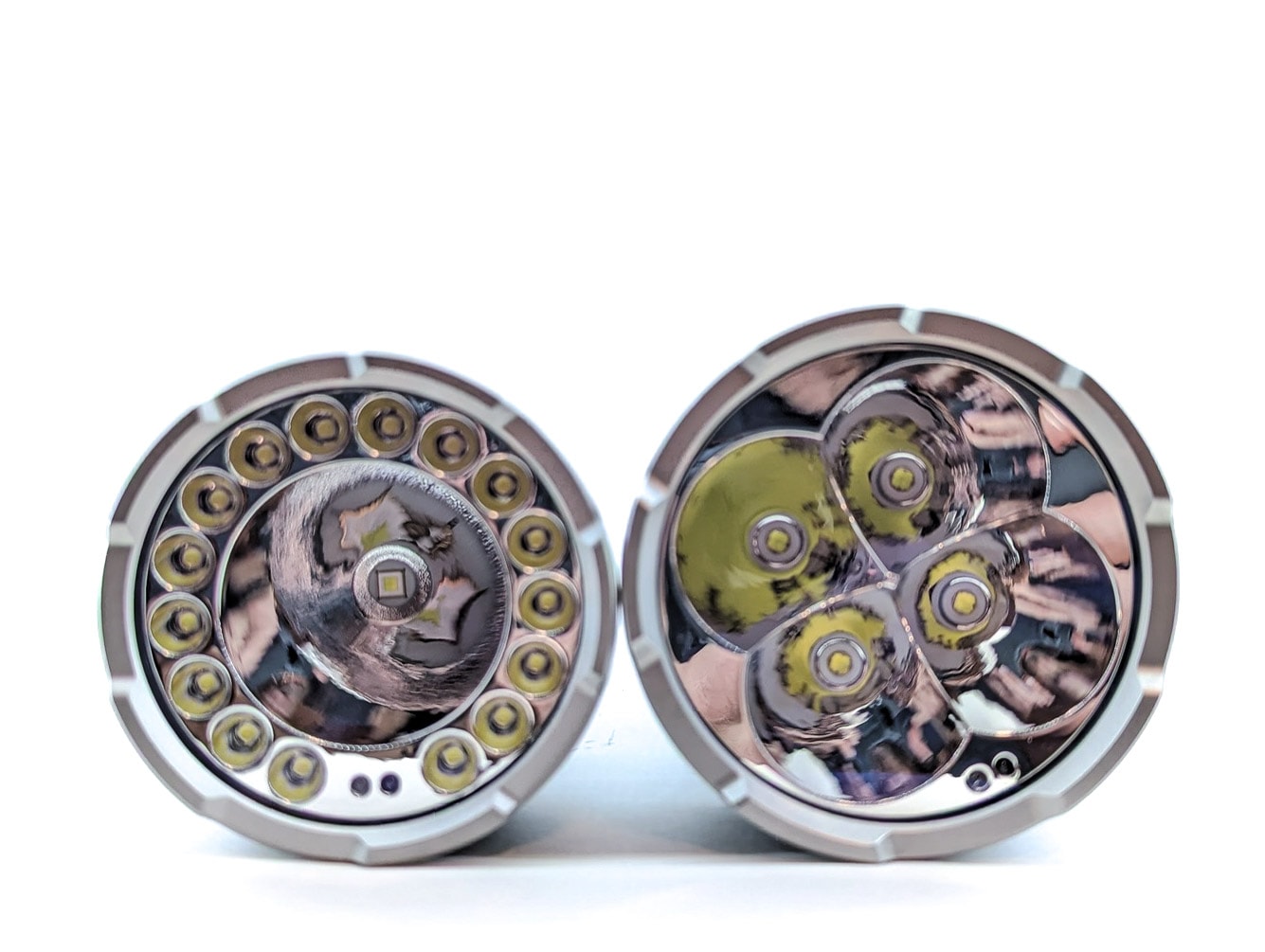
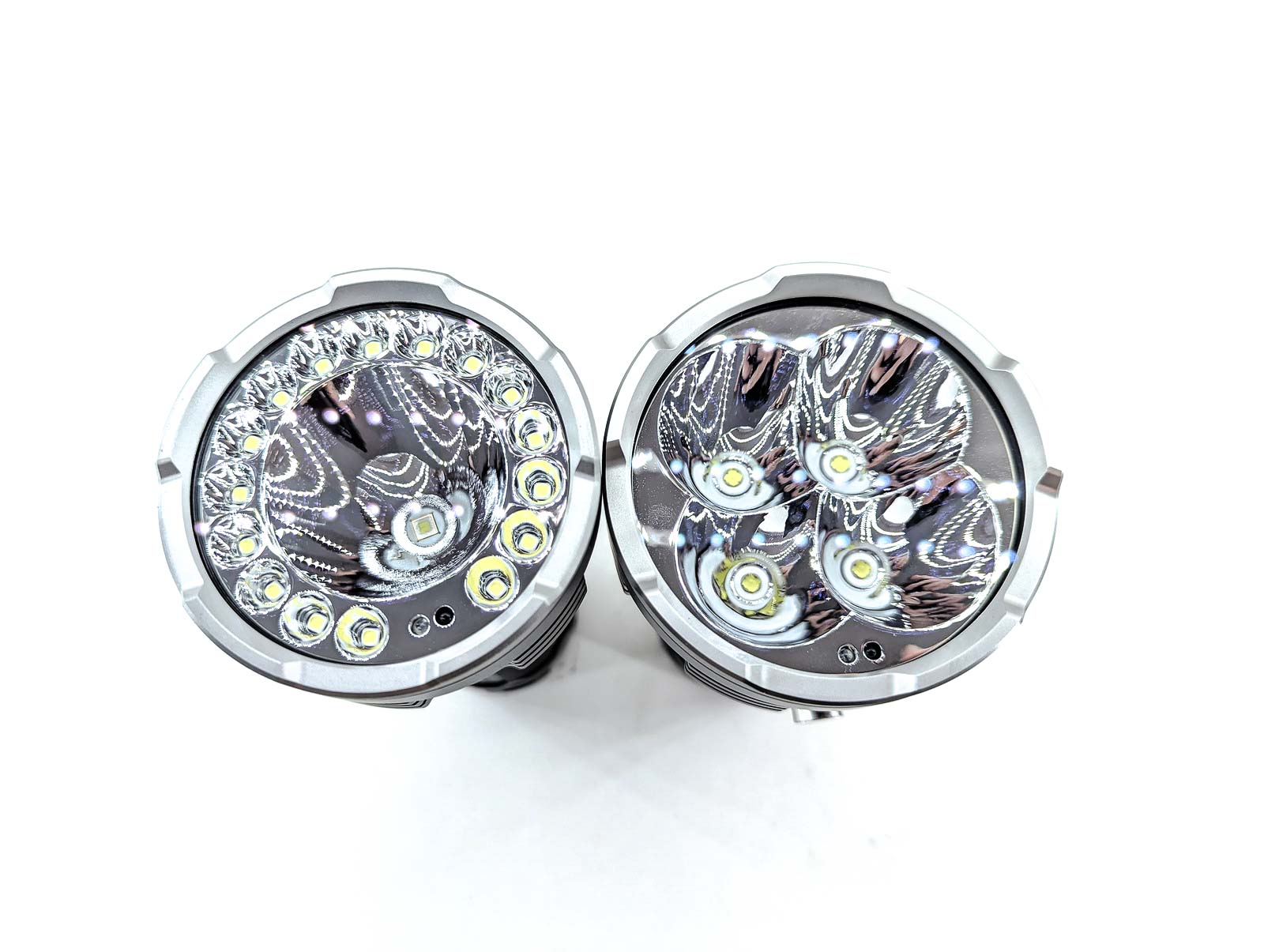
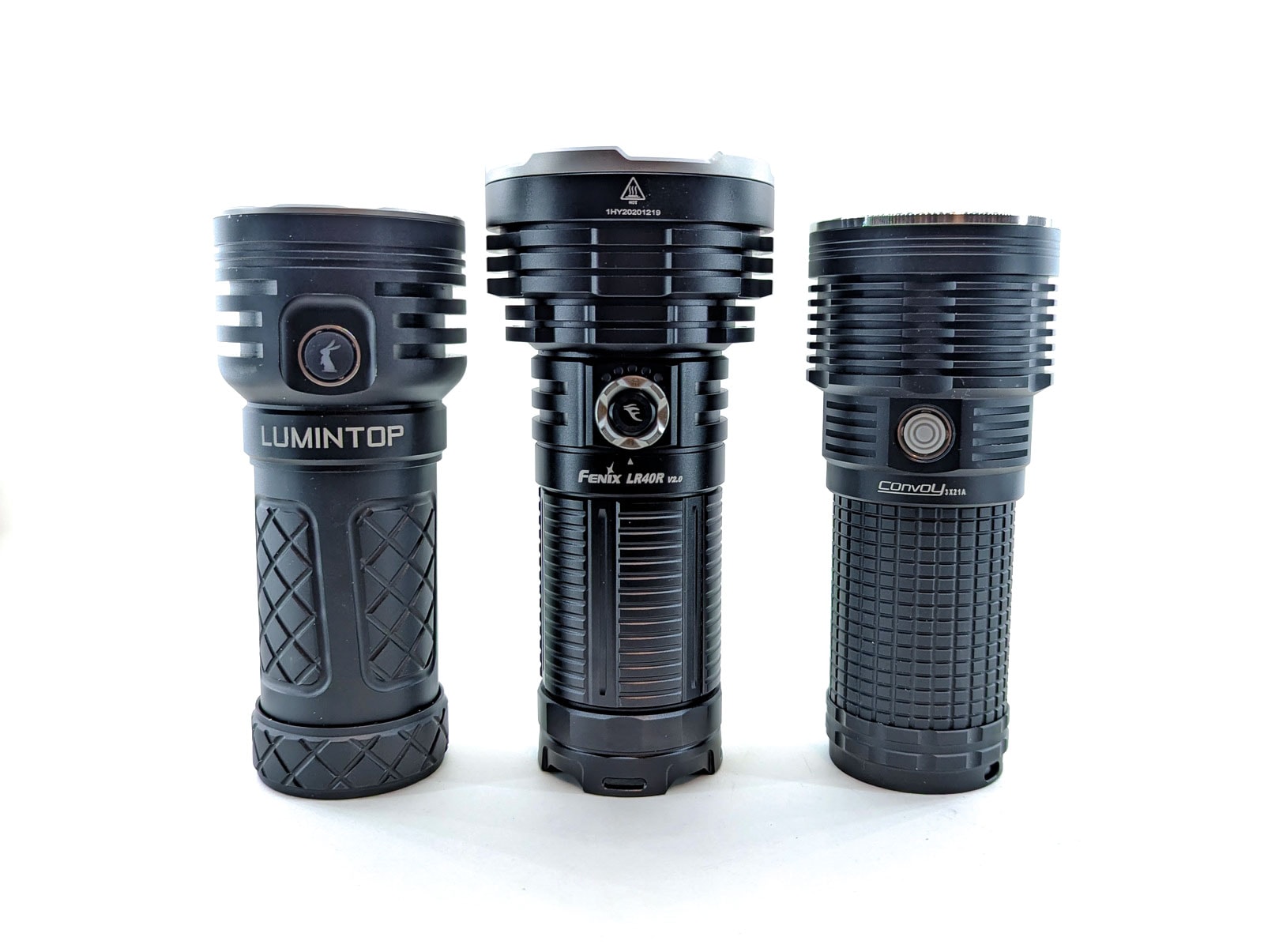
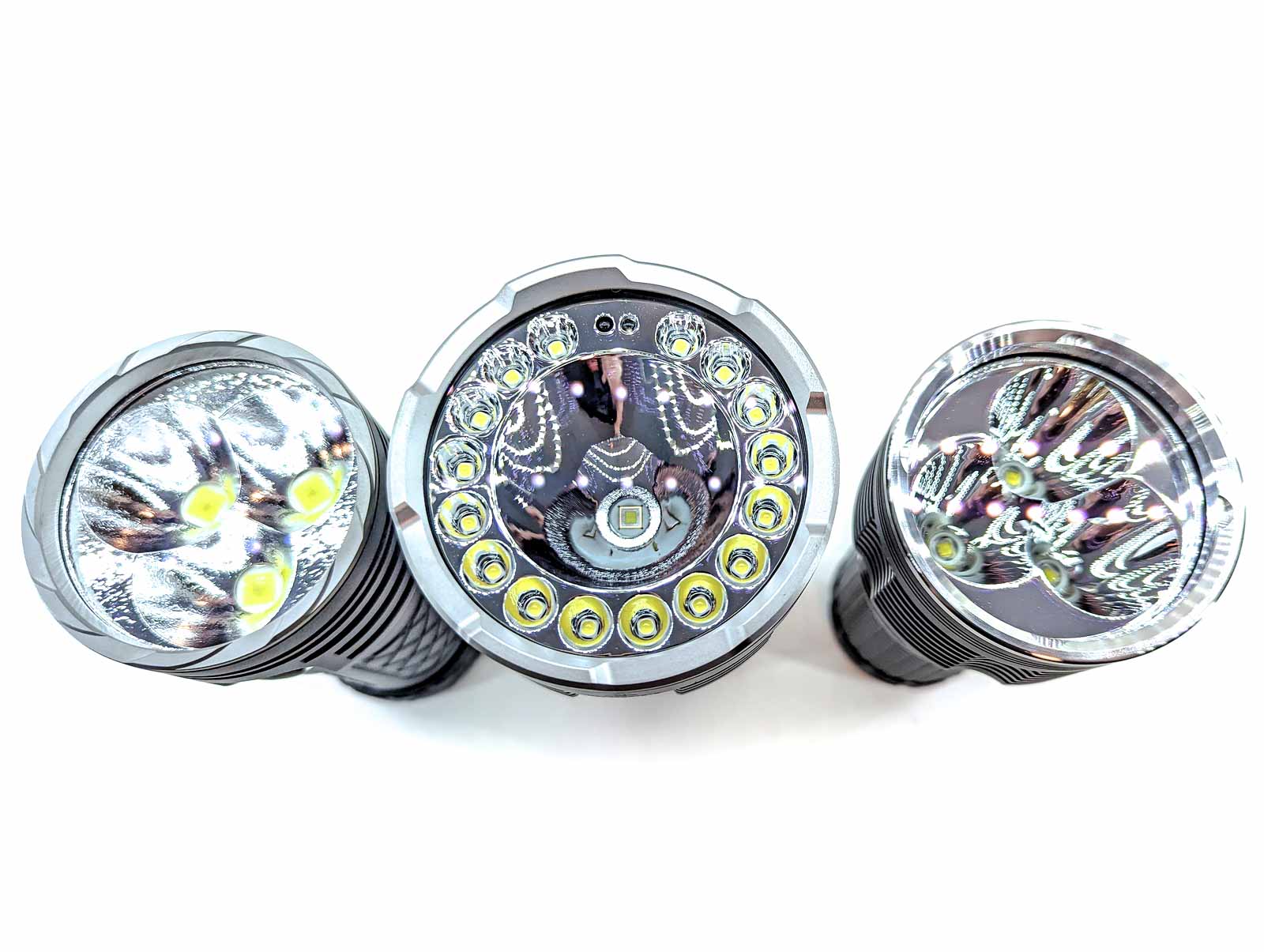
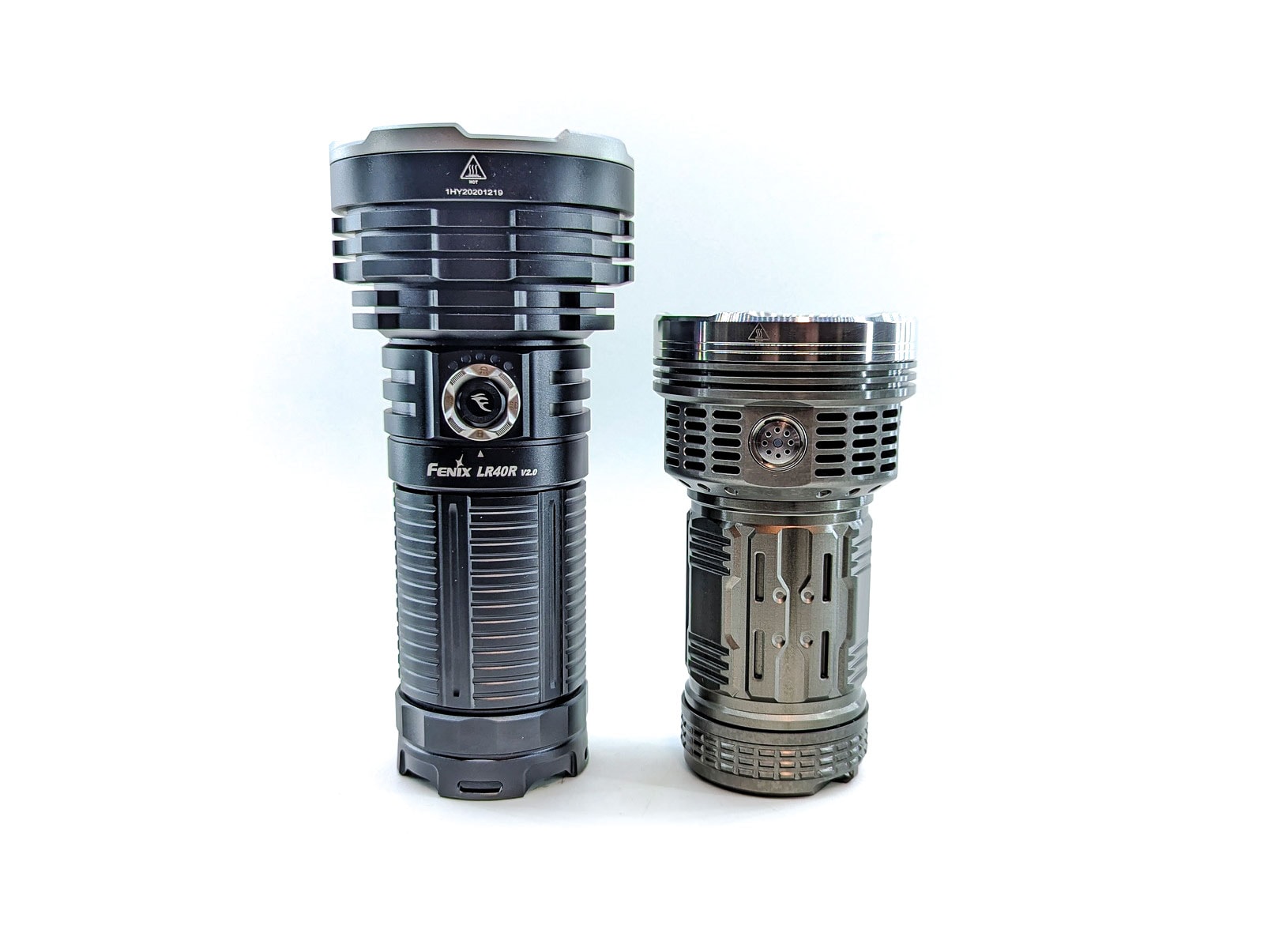
Fenix LR40R v2 UI: User Interface and Driver
Operating the Fenix LR40R V2.0 is relatively simple: select the desired output mode with the “rotary toggle switch” and then use the electronic switch in the middle of the ring to turn it on and change brightness levels. Note that the light arrives with the rotary switch set to Lock – just rotate it to Spotlight, Floodlight, or Spot+Flood and you’re off to the races!
This simplicity is my favorite difference when I set the LR40R V2.0 next to the LR50R. Since I don’t use the LR50R too often, I end up pulling up the manual every time I go to use that 2-button interface. That’s frustrating. The LR40R V2.0’s controls are intuitive (at least if you’ve ever used a Fenix e-switch light).
Available modes:
- Spotlight: Eco, Low, Med, High
- Floodlight: Eco, Low, Med, High, Turbo
- Spot + Flood: Eco, Low, Med, High, Turbo
Available blinky modes:
- Strobe, SOS
From OFF:
- Press and hold 0.5 sec: turn On
- Press and hold 1.2 sec: Strobe
From ON:
- Press and hold 0.5 sec: turn Off
- Press and hold 1.2 sec: Strobe
- 1 click: change brightness
Mode memory:
- When using the rotary switch and moving it from Locked (1st position) to Spotlight (2nd position), it will always come on in Eco mode
- When using the rotary switch and moving to Floodlight (3rd position) or Spot + Flood (4th position), it will come on in the memorized mode
- When using the e-switch to turn the light on/off, it will come on in the memorized mode
- So if you’re not sure what mode the LR40R V2.0 is in and you don’t want to blind yourself, just rotate the ring to Locked and then back to Spotlight
Shortcuts:
- To Low: rotate the ring from Locked to Spotlight
- To Strobe: press and hold 1.2 sec from On or Off
Low voltage warning:
- Above the rotary switch are 5 blue LEDs that indicate the battery level
Strobe/blinkies
- Strobe mode: activate by press and holding the switch 1.2 sec from On or Off
- SOS mode: single click from Strobe mode
- To exit, single click again from SOS to exit to the last-used mode
Lock-out mode:
- Turn the rotary switch to Lock
PWM
- None (verified with a photo-diode and my DMM’s frequency setting)
Additional/summary info on the UI:
- There are two ways of turning the light off:
- Just rotate the rotary switch to Locked (rotate back to unlock and turn on)
- Press and hold the e-switch 0.5 sec for On / Off
- There is also an “intelligent brightness downshifting sensor” that automatically lowers the output if something comes close to the lens (around 60mm) for more than 1.5 sec
- If desired, this protection can be disabled (and re-enabled) by moving the rotary switch to the Locked position and holding the e-switch for 5 seconds. Two flashes means the sensor was just enabled; eight flashes for disabled.
- My manual reads incorrectly about this interaction. It says “with the light unlocked, press and hold the electronic switch for over 10 seconds”, but doing that just blinds yourself with Strobe mode. The website has this corrected; I imagine the manual will likely get revised.
Fenix LR40R v2 Charging and batteries
While the original LR40R used a 43.2 Wh battery pack consisting of 4x 18650 batteries (or individual 18650s could be used as a backup), the new V2.0 version uses a 54.0 Wh battery pack that’s built from 3x 21700 batteries. With the LR50R I have, you could take out the battery pack and use 1-4 18650’s in a pinch. The original LR40R also allowed that. As best as I can tell, the LR40R V2.0 is sealed up tight – there is no removing that battery pack.
The searchlight features built-in USB-C charging, supporting QC2.0 and PD2.0 protocols. According to Fenix, the battery pack can be charged up in as little as 4 hours. In my testing, I used a QC charger and saw a charge rate of 17.0 watts (1.92 amps at 8.84 volts) and the charge cycle completed in 3 hours and 54 minutes, transferring 58.6 Wh of power. I also tried charging with a 33W PD3.0 power supply and for some reason it didn’t want to charge very fast, taking almost 7 hours. Perhaps when not connected through a USB meter, the flashlight might negotiate a faster charge rate, but I’m not so sure.
Powerbank feature
The USB-A port that sits right below the USB-C can also be used to provide power to your devices, such as recharging your phone or other gear. I plugged my phone in using the USB-A port and saw a 7.7 watt charge rate. From what I can tell, the USB-C port is not to be used with the powerbank function.
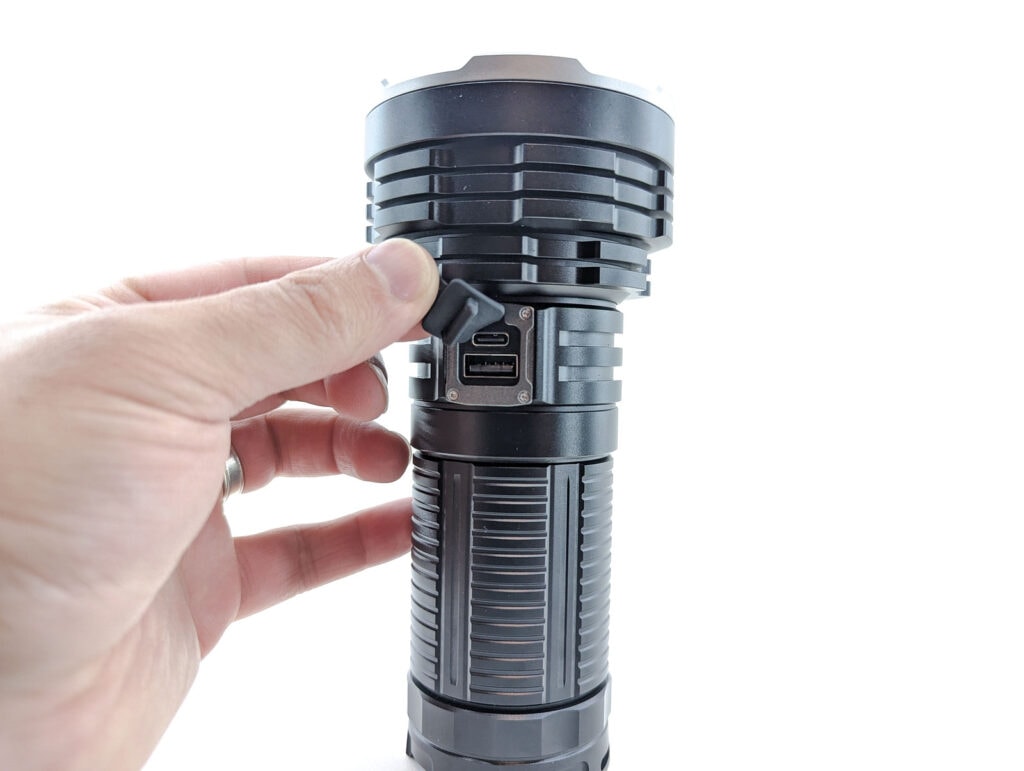
Performance test
Lumen measurements
How Lumens are Measured: Understanding ANSI FL1 Standards How Lumens are Measured: Understanding ANSI FL1 Standards: The ANSI FL1 standards specify that output in lumens should be measured 30 seconds after turning on, as this is the standardized time for measuring brightness according to the industry standard. This is why we focus on this part in our measurements. The ANSI FL1 standards require an ambient temperature of 22 ± 3°C. We record the ambient the ambient temperature to identify potential reasons for any observed discrepancies.Lux was measured by a UNI-T UT383 BT at 5 meters. Lumens were measured in a homemade lumen tube using a VEML7700 sensor, calibrated with a calibration light provided by 1Lumen. The provided battery pack was used for testing.
Lumen measurements (for each mode)
| Mode | Specs | turn on | 30 sec | 10 minutes |
|---|---|---|---|---|
| Spot, Eco | 10 lm | 18 | 18 | – |
| Spot, Low | 500 lm | 630 | 628 | – |
| Spot, Med | 1,500 lm | 1,997 | 1,962 | 1,920 lm |
| Spot, High | 3,000 lm | 4,158 lm | 3,767 lm | 2,905 lm |
| Flood, Eco | 100 lm | 124 | 124 | – |
| Flood, Low | 1,000 lm | 1,293 | 1,292 | – |
| Flood, Med | 3,000 lm | 3,916 | 3,913 | – |
| Flood, High | 8,000 lm | 10,110 | 9,902 | 7,295 lm |
| Flood, Turbo | 12,000 lm | 14,998 lm | 13,632 lm | 2,452 lm |
| Both, Eco | 300 lm | 402 | 401 | – |
| Both, Low | 1,500 lm | 2,152 | 2,150 | – |
| Both, Med | 5,000 lm | 6,873 | 6,857 | – |
| Both, High | 10,000 lm | 13,092 | 12,806 lm | 3,054 lm |
| Both, Turbo | 15,000 lm | 20,070 lm | 14,225 lm | 2,983 lm |
Parasitic drain:
- N/A, could not measure due to internal battery design
Whew… there’s a lot to test on this bad boy. In the brightest of the bright modes (Spot + Flood, Turbo), it started a good margin brighter than spec. However, ANSI spec says the reading is taken at 30 seconds, and by that time the LR40R V2.0 was throttling back. Even so, the 14,225 lumens is barely below the 15,000 spec. Pretty much everything else that was tested came out above Fenix’s spec.
Fenix LR40R Battery Life: Runtime graphs
How Runtimes are Measured: Understanding ANSI FL1 Standards About ANSI FL1 runtime standards: The runtime is measured until the light drops to 10% of its initial output (30 seconds after turning on). This does not mean that the flashlight is not usable anymore. The last column shows how long the light actually works till it shuts off. If there is a + symbol, it means that the test was stopped at that particular point, but the light was actually still running. This happens on certain occasions, with certain drivers, firmware, or batteries.| Mode | Specified | Measured runtime ANSI | Time till shut off |
|---|---|---|---|
| Spot, Eco | 177h | – | – |
| Spot, Low | 14h 10min | – | – |
| Spot, Med | 3h 40min | 3h 39min | 3h 40min+ |
| Spot, High | 3h | 2h 24min | 8h 53min+ |
| Flood, Eco | 50h | – | – |
| Flood, Low | 11h | – | |
| Flood, Med | 3h | – | – |
| Flood, High | 2h 30min | 2h 36min | 5h 30min+ |
| Flood, Turbo | 2h 30min | 2h 20min | 3h 33min+ |
| Both, Eco | 25h | – | – |
| Both, Low | 6h | – | – |
| Both, Med | 2h 40min | – | – |
| Both, High | 2h 30min | 2h 58min | 6h 12min+ |
| Both, Turbo | 2h 30min | 2h 50min | 2h 59min+ |
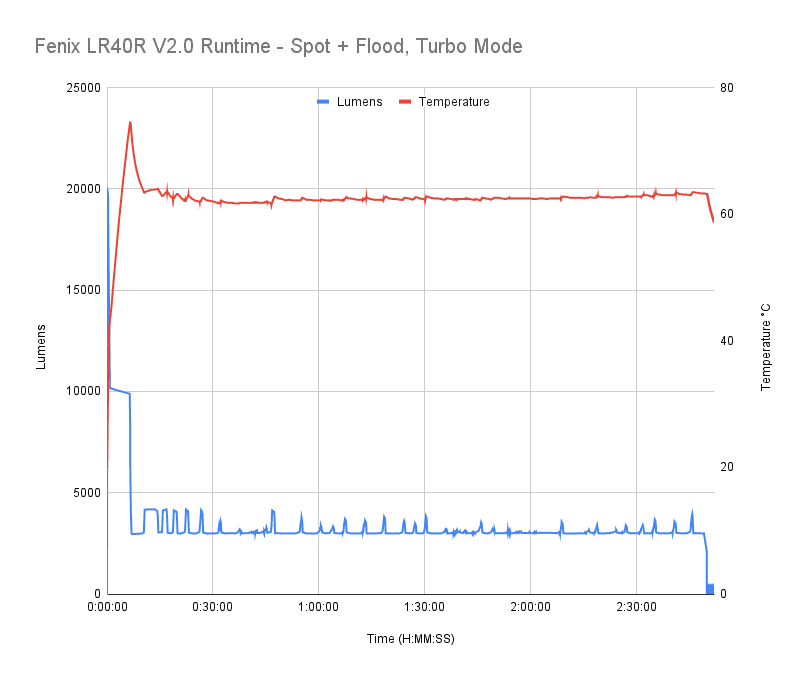

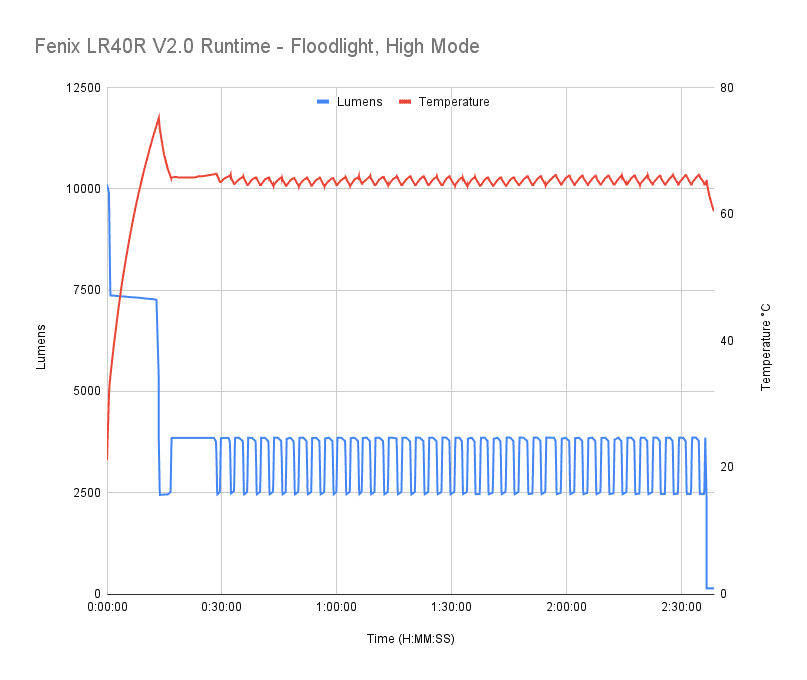
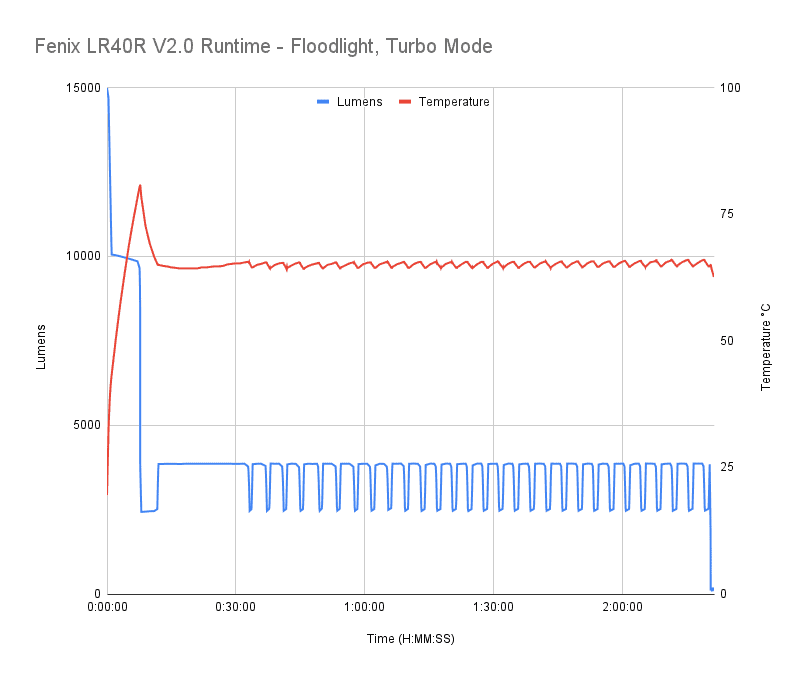
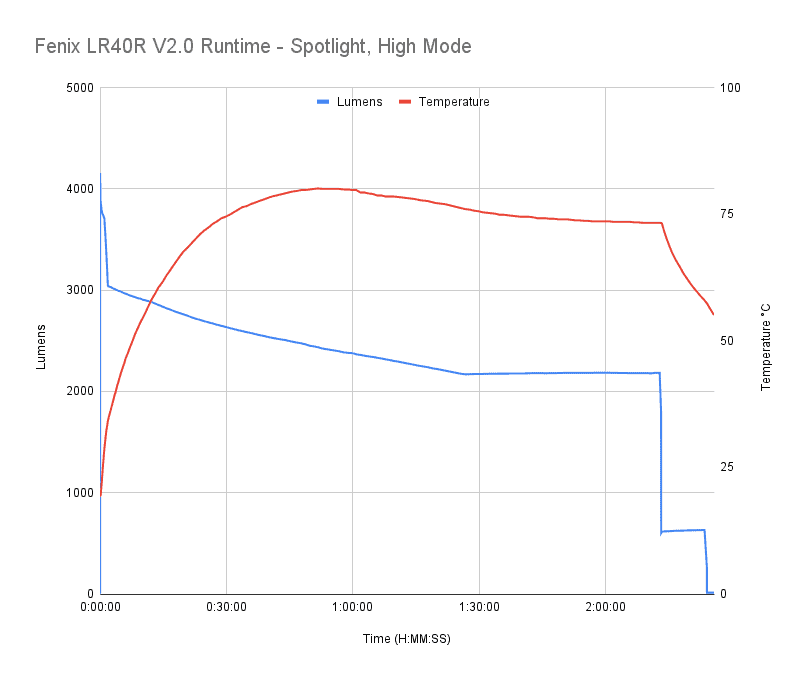
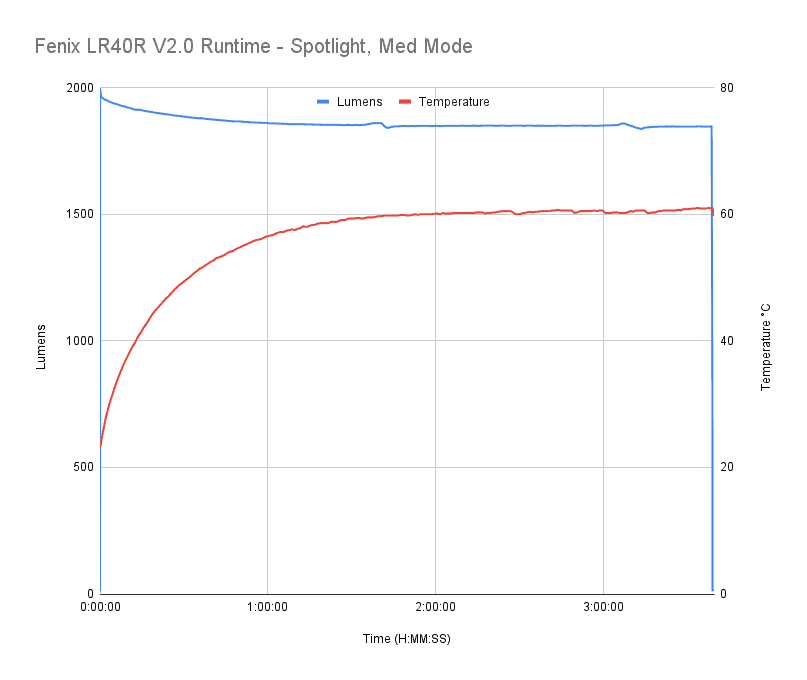
By and large, my runtime observations line up well with Fenix’s claims. Note that once the output dropped down to its lowest level (around 64 lumens), it kept chugging along for hours and hours until I finally stopped the tests.
Peak beam intensity and beam distance measurements
About Peak beam intensity: Understanding ANSI FL1 Standards About peak beam intensity The calculated value of distance in meters at which the flashlight produces a light intensity of 0.25 lux. (0.25 lux is about the brightness of a full moon shining on an object). This means that the intensity has decreased so much, it becomes difficult to see darker objects, or objects that don’t reflect light. The columns ‘Meters’ and ‘Yards’ use rounded numbers.Intensity was measured at 5 meters after being turned on for 30 seconds. A UNI-T UT383 BT lux meter was used.
| Mode | Specified | Candela measured | Meters | Yards |
|---|---|---|---|---|
| Spot, Eco | 812 cd | 750 cd | 55 m | 60 yd |
| Spot, Low | 35,272 cd | 31,175 cd | 353 m | 386 yd |
| Spot, Med | 106,416 cd | 86,700 cd | 589 m | 644 yd |
| Spot, High | 196,464 cd | 177,650 cd | 843 m | 922 yd |
| Flood, Eco | 251 cd | 300 c | 35 m | 38 yd |
| Flood, Low | 2,385 cd | 2,375 cd | 97 m | 107 yd |
| Flood, Med | 7,264 cd | 7,000 cd | 167 m | 183 yd |
| Flood, High | 19,580 cd | 18,250 cd | 270 m | 295 yd |
| Flood, Turbo | 28,189 cd | 27,500 cd | 332 m | 363 yd |
| Both, Eco | 15,153 cd | 20,525 cd | 287 m | 313 yd |
| Both, Low | 37,501 cd | 31,450 cd | 355 m | 388 yd |
| Both, Med | 87,344 cd | 74,900 cd | 547 m | 599 yd |
| Both, High | 153,188 cd | 127,725 cd | 715 m | 782 yd |
| Both, Turbo | 203,568 cd | 180,000 cd | 849 m | 928 yd |
In general, my intensity measurements seem to be a bit lower than Fenix’s. Part of the Spot + Flood Turbo test coming in lower could be related to the thermal throttling. The spotlight LED (the SFT70) is ever-so-slightly out of center on my sample, so it’s possible that is contributing a small amount.
Beamshots
Camera settings and distance:
Beam shots of the building are taken at 50 m (55 yd) using a Pixel 7 set to ISO 800 with 1/20 second exposure time
Beamshots of the following flashlights compared:
- Fenix LR40R V2.0
- Lumintop Rattlesnake
- Astrolux FT03S SBT90.2
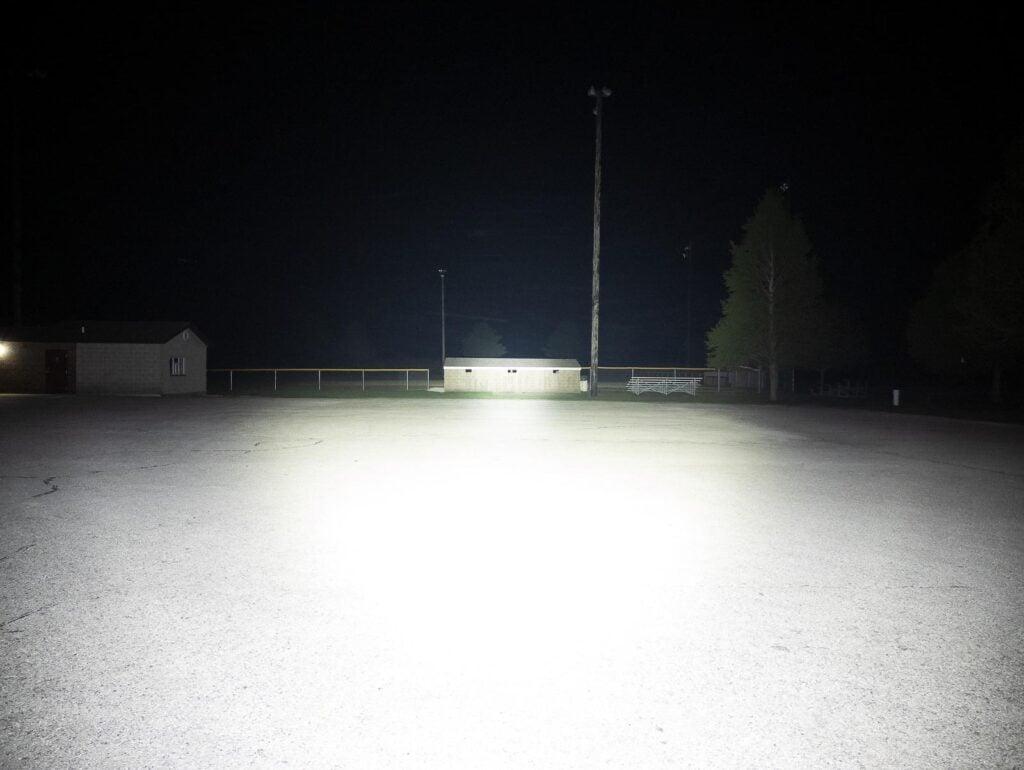
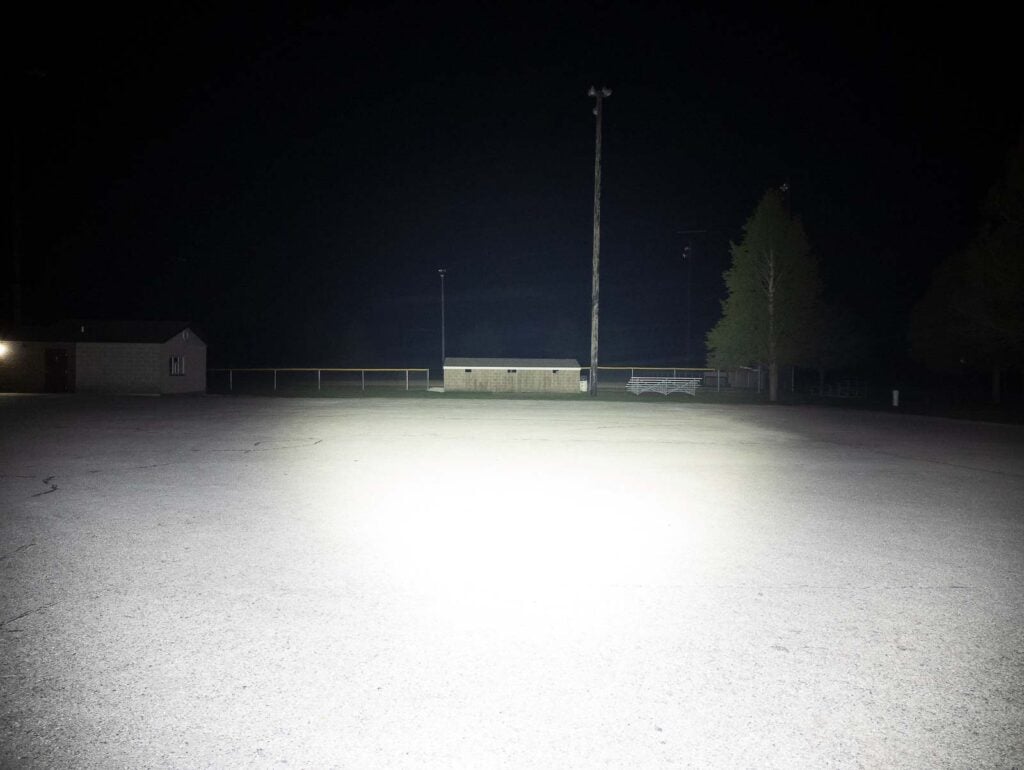
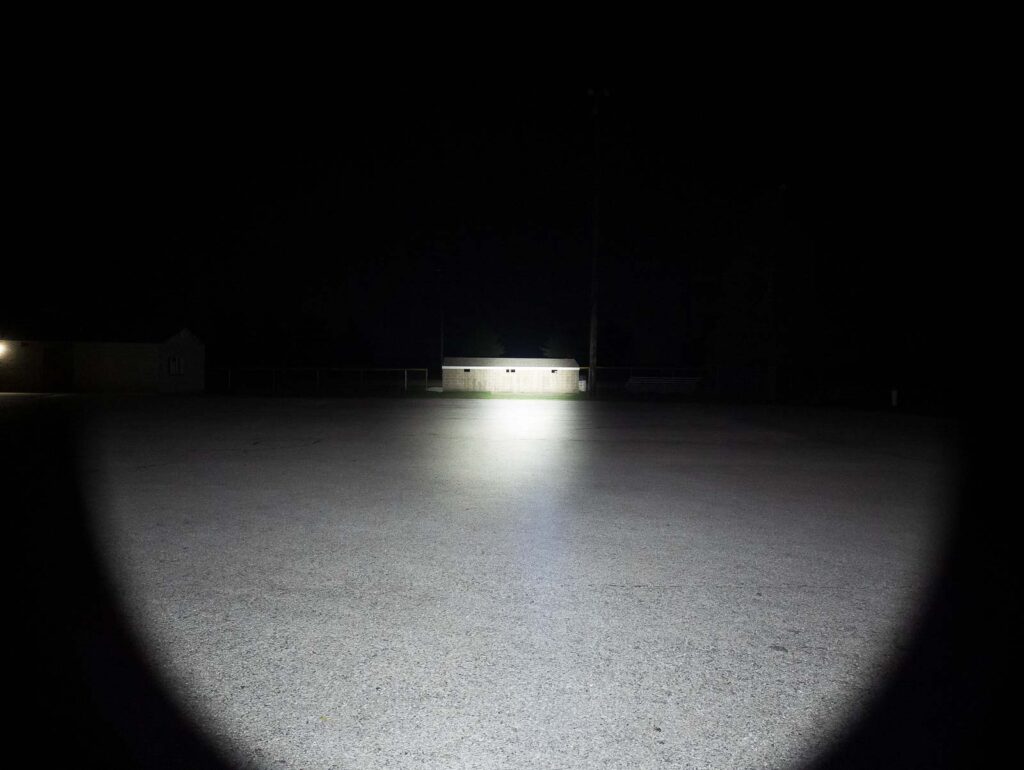
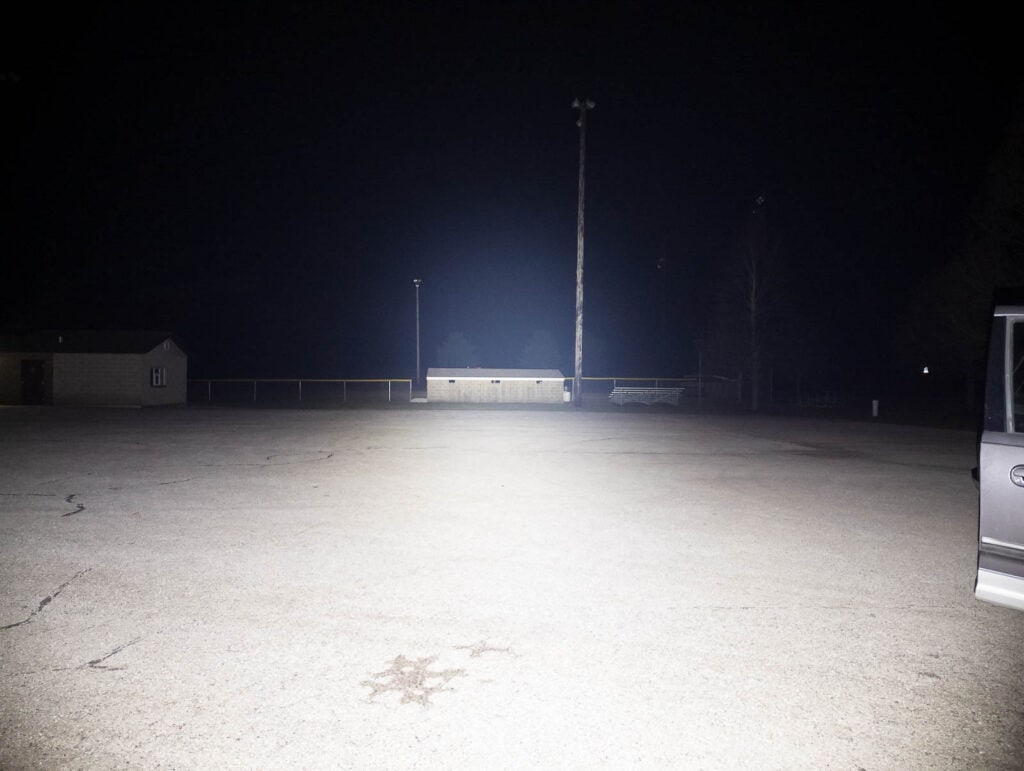
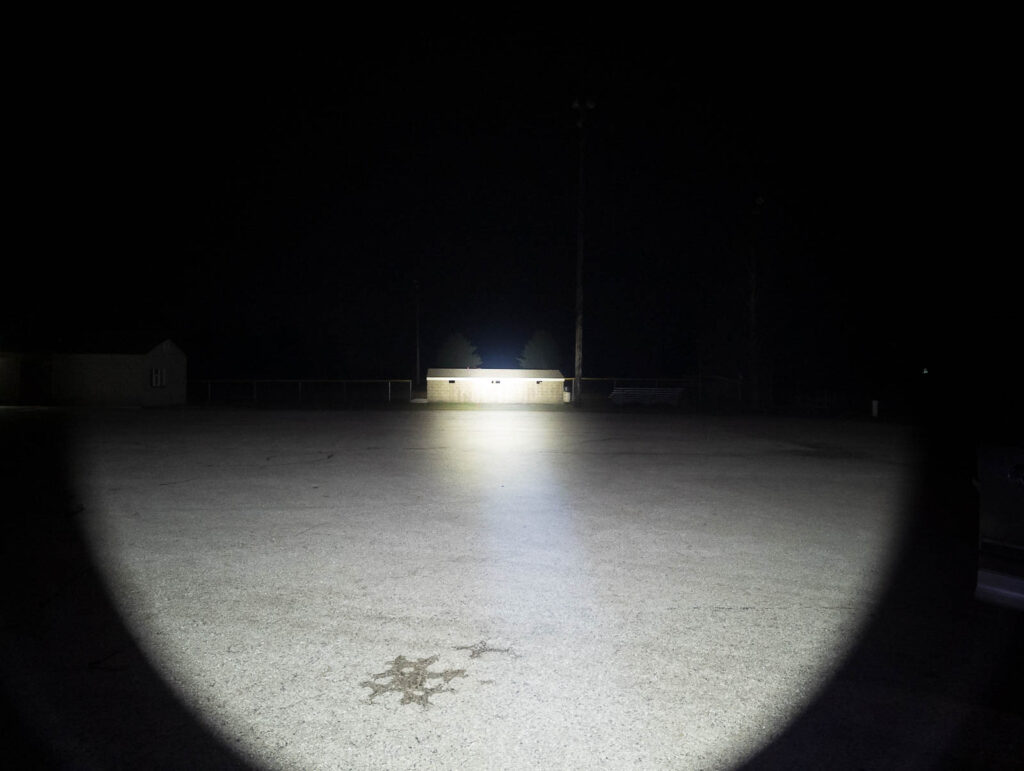
Disclaimer: This flashlight was sent to me for review at no cost by Fenix. I have not been paid to review, nor have I been holding back on problems or defects.
Final Verdict
Pros
- Great combination / option of Spot + Flood
- Trusted Fenix build quality
- Great output and sustained output
- Long runtimes
- Fast charging with USB-C
- Powerbank functionality
- Much improved UI
Cons
- Missed intensity spec
- No USB-C output
- No tripod mount
Explanation on star ratings:
1: Avoid: a match would be a better choice – 2: Poor: significant defect or issues; almost unusable – 3: Average: some defects or issues; but still usable 4: Good: recommended (minor issues) – 5: Great: highly recommended

4.5 stars: ★★★★⋆
While our star rating provides a reliable indicator, we encourage you to read the full review to make an informed decision based on your own needs and preferences.
Over the past two years, whenever I wanted to show off a truly impressive flashlight, I frequently reached for the Fenix LR50R – it’s just so big, bold, bright, and well-built. The new LR40R V2.0 builds on that legacy, but brings dual-channel capabilities to the table. Oh, and the new rotary switch + e-switch controls are a lot more intuitive over the previous lights. Aside from slightly missing the intensity specs (by my measurements) and the lack of a tripod mount, I can’t find much to complain about. The Fenix LR40R V2.0 is a great “search and rescue” light… and likely another other task you throw its way.
Buy your Fenix LR40R v2 with a discount
Get 10% off every purchase at Fenix Lighting US, by using our exclusive 1lumen discount code: 1lumen10
1lumen selects and reviews products personally. We may earn affiliate commissions through our links, which help support our testing.